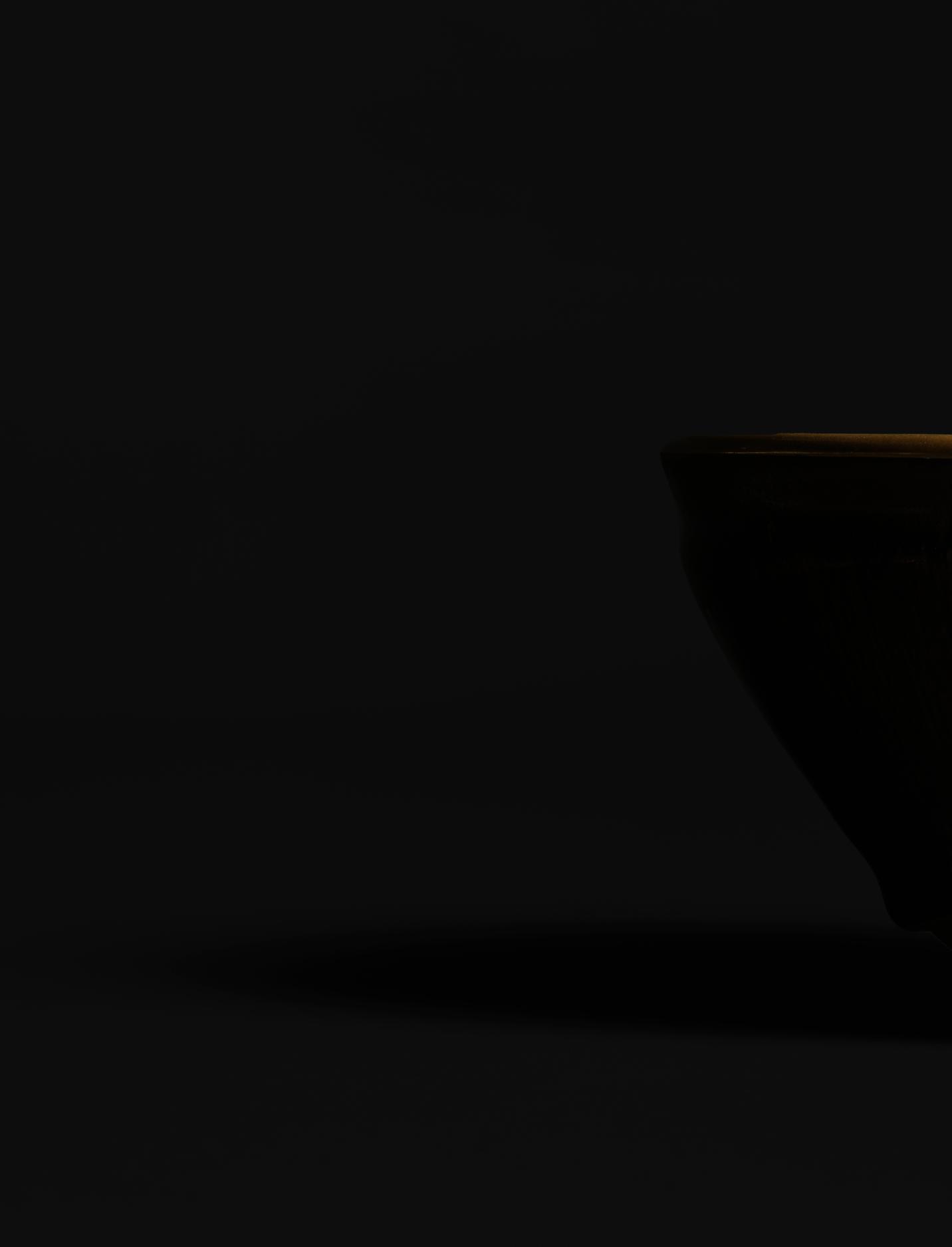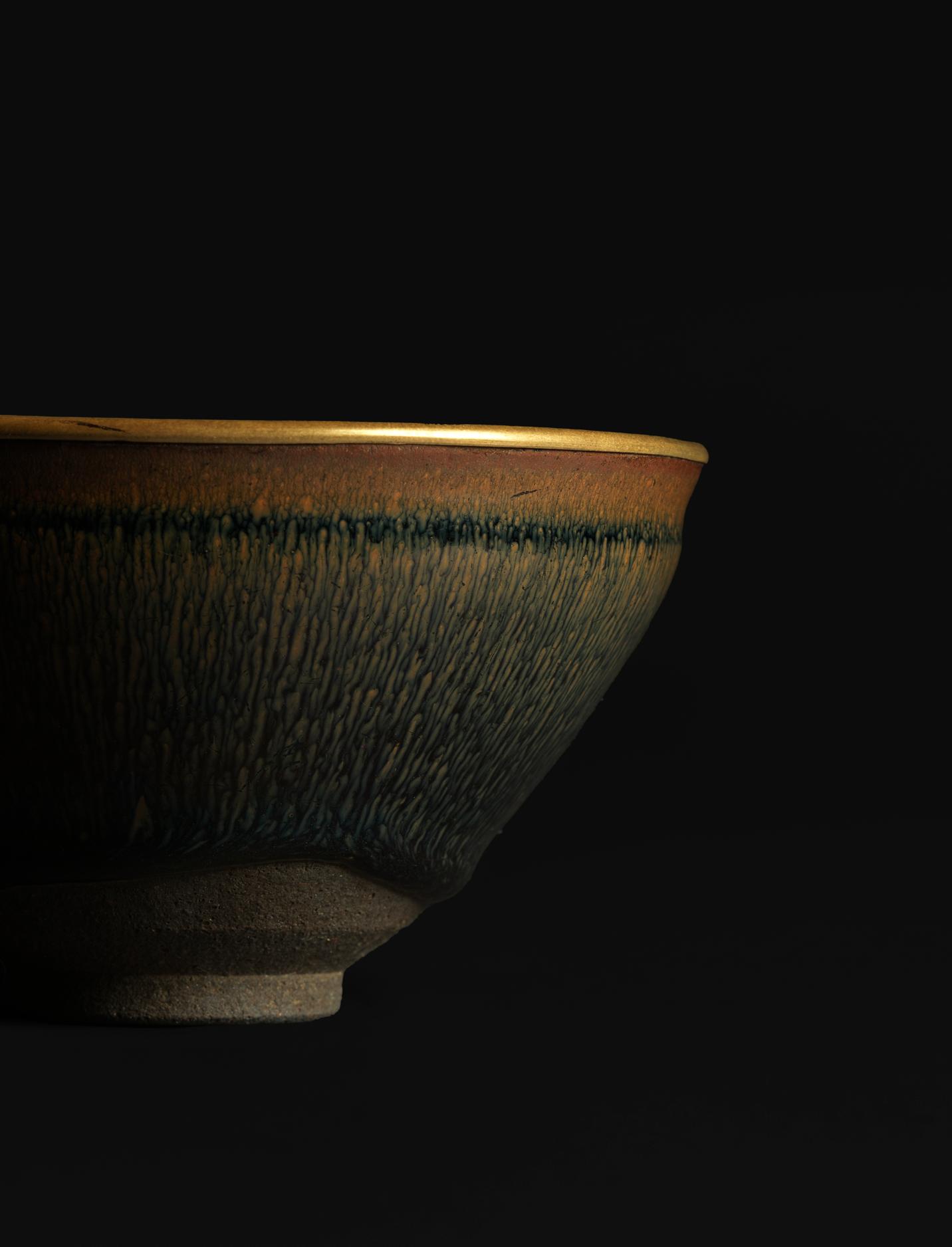
Chinese ceramics, metalwork and lacquer from the 12th to the 14th century


Chinese ceramics, metalwork and lacquer from the 12th to the 14th century
ISBN: 978 1 873609 58 3
Design, Typesetting Daniel M. Eskenazi, London
Photography Daniel M. Eskenazi, London
Printed and originated by Graphicom Srl., Vicenza
© copyright 2025 ESKENAZI London
Chinese ceramics, metalwork and lacquer from the 12th to the 14th century
27 October - 14 November 2025
10 Clifford Street
London W1S 2LJ
Telephone: 020 7493 5464
e-mail: gallery@eskenazi.co.uk web: www.eskenazi.co.uk
情趣高雅且思想活跃的十二至十四世纪始终是本艺廊最钟爱的中国历史时期 之一。本次展览汇集了陶瓷器、漆器与金器精品,展现这一时期物质文化所 特有的典雅内敛与精湛技艺。
这份精神特质体现在每件展品之中——从定窑碗米白釉面的剔刻纹饰, 到钧窑盘蓝釉紫斑的窑变效果;从葵口漆盘的优雅造型,到金鋬耳杯的精美 錾刻和流转光泽。
与历届展览一样,我们希望观众不仅将这些珍宝视为历史文物,更要体 会它们所承载的那个艺术、哲学与日常生活深刻交融时代的精神。
在此特别感谢家父——在这个历经巨变的年代里,他始终如一的支持令 我铭感于心。若无王嘉慧女士严谨的研究、细致的编目及深刻的专论,本图 录将无法问世,对此我深表谢忱。同时,感谢朱玲博士为中文读者精心翻译 了王嘉慧的文本。
Daniel Eskenazi
Foreword
The refined and intellectually vibrant 12th to 14th centuries remain one of the gallery’s favourite eras in Chinese history. This exhibition brings together examples of ceramics, lacquerware, and goldwork that reflect the elegance, restraint, and technical mastery that defined the period’s material culture.
The spirit of refinement is evident in every piece—from the subtle carved Dingyao bowl with a light cream glaze to the bold blue-glazed, purple-splashed Junyao dish, or from the elegant, mallow-shaped lacquer dish to the delicately chased luminous gold cup.
As always we invite visitors to explore these treasures not only as historical artifacts but as expressions of a time when art, philosophy, and daily life were deeply intertwined.
I would like to thank my father for his continued support in a world that has seen much change over the last few years. This catalogue would not have been possible without Sarah Wong’s research, meticulous cataloguing, and insightful essay, for which I am most grateful. I would also like to thank Dr Ling Zhu for translating Sarah’s texts into Chinese for our Chinese readers.
Daniel Eskenazi
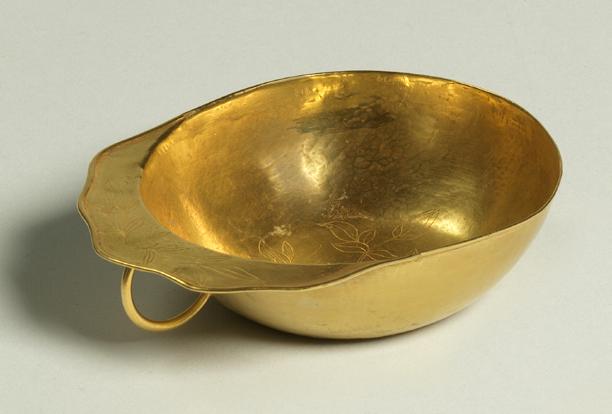
1

Gold cup with chased motifs, Xixia, Jin or Yuan dynasty, 12th - 13th century; max. width: 11.4cm, cup diameter: 9.4cm, height: 2.9cm. Number 8 in the present catalogue.
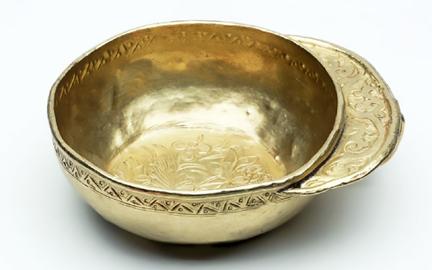
2
Gold cup with chased motifs, Yuan dynasty; diameter: 7.0cm, height: 4.0cm. Victoria and Albert Museum, London, M.301935. Purchased with Art Fund support, the Vallentin Bequest, Sir Percival David and the Universities China Committee.

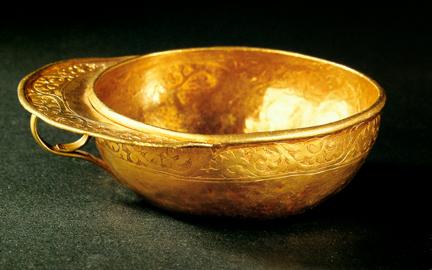

A Cup of Gold with Lotus Flowers
by Sarah Wong
This striking drinking cup is a rare and elegant example of goldsmithing, probably made in the north China region, around the twelfth to thirteenth centuries. However, its specific and unusual features – the low cup shape rising from a flat base and the lobed, flanged thumb-rest with a ring handle beneath –mark it out as being a form that is not traditional to the Chinese metalworking repertoire of that time (fig. 1, catalogue number 8). Unlike classic Chinese drinking vessels, whether for wine or tea, it does not have a supporting stem or foot-ring. This essay will attempt to place this cup in context, both in terms of dating and region. It will consider similar and, more distantly related examples, possible design sources, as well as its cultural significance and possible use and, finally, its reflection in Chinese ceramic forms of the period.
The early twentieth century collecting history of the present cup is well documented, as listed on page 50 of the present catalogue. It is first recorded as being in the possession of Zhang Renjie (1877 - 1950), also known as Zhang Jingjiang, a successful businessman, Nationalist Government official and art dealer, who established the Tonying and Company (Tongyun Gongsi), with branches in Paris, Shanghai, New York. 1 It seems likely that he acquired the cup around the early twentieth century, directly in China where he had extensive contacts, as explained by Nick Pearce, op. cit.:
Because of Zhang’s position in China, the Company was able to source high quality works of art directly, including items from the old Imperial Collection. A long-standing friend from his Paris days was Li Shizeng, who became chairman of the newly created Palace Museum in 1925 and was responsible for the inventory of the Imperial Collections. Zhang also oversaw the beginning of the removal of more than half of the Imperial Collections to Shanghai in 1933 following the Japanese invasion of Manchuria.
The cup may then have been acquired directly from the Tonying and Company branch in New York by its next owner, Mrs Christian R. Holmes (1871 -1941) of Long Island, the famous philanthropist and collector. Her extensive art collection, housed at her home, The Chimneys, at Sands Point on Long Island, included outstanding Chinese bronzes, ceramics and jades most of which were sold in 1941.
The cup was subsequently owned by The Honorable Hugh Scott (1900 - 1994), the Republican Representative and Senator from Pennsylvania who formed a collection of Tang (618 - 907) ceramics and works of art. He published part of his collection in his book, The Golden Age of Chinese Art: The Lively Tang Dynasty , including the present cup which was dated as ‘T’ang dynasty (Possibly early Sung)’. 2 Scott lent the cup to numerous exhibitions in the USA, including the ground-breaking Early Chinese Gold & Silver , at the China Institute in America, New York in 1971. 3 By the time of this last exhibition, it had been dated by Paul Singer op. cit., to the Song dynasty (960 - 1279), rather than the Tang.
There are only a few known similar examples in gold featuring a shallow cup on a flat base, with a flanged thumb-rest and ring handle within the Chinese metalwork repertoire. It is likely that such cups were only made in small numbers, for the use of the elite and in addition, being made of precious metals, easily melted down, many would not have survived the centuries. One closely related cup in gold, now dated to the Yuan dynasty (1271 - 1368), is in the Victoria and Albert Museum, formerly in the George Eumorfopoulos (1863 - 1939) collection (fig. 2). 4 It is chased on the interior with lotus blooms; the flange, which is crescent-shaped rather than lobed, is decorated with a classic scroll. While the exterior of our present example is softly burnished but undecorated, the V&A example is ornamented with a diaper pattern around the rim. The rim and the flange have a raised edge, similar to the present cup.
A second gold example of this type of cup, also dated Yuan, was excavated in 1976 from Wujiadicun, Wuguquan village, Xinghe county and is now in the Inner Mongolia Museum (fig. 3). 5 This version also has a crescent-shaped thumb-rest above a ring handle with a supporting arm. Classic scroll is chased on the flange and around the exterior rim. Both the rim and the flanged thumb-rest have a raised edge.
A third, and very similar, gold cup of this design, dated Yuan, was found at the Wuyi Ranch, Plain Blue Banner, Xilingol League and is now in the Inner Mongolia Museum (fig. 4). It is very close in shape to the above example in the Inner Mongolia Museum, although the ring handle does not have a supporting arm. This cup is chased with a delicate design of two dragons and a flaming pearl on the crescent-shaped thumb-rest, a decorative roundel in the well and a classic scroll beneath the rim, enclosed by a doubleline border. 6
An interesting and, more elaborate variant on this shape, is the gold bowl or cup with a similar flat base, with a thumb-flange and ring handle, but with fluted sides and rim, included in the 2010 Metropolitan Museum of Art exhibition, The World of Khubilai Khan, Chinese Art in the Yuan Dynasty , and in the collection of the Inner Mongolia Museum (fig. 5). 7 This cup also has a decorated thumb-rest and a floral scroll within double lines at the rim. James Watt, op. cit., refers to it is as one of the vessels ‘that originated in nomadic culture and that had long been adopted in North China, are objects that the Tanguts of the Xixia state would have used’. Also included in the same exhibition was a gold fluted cup
but without a thumb-rest or ring, supported on a matching, fluted stand; the cup is assigned to the Xixia dynasty (1038 - 1227) and is now in the Inner Mongolia Museum. 8
Related to this discussion is another Yuan dynasty fluted gold cup with flat base, with a wide raised edge around the rim but otherwise undecorated. The arrangement of the thumb-rest is a little different: it is of narrow rectangular form with a vestigial curving loop below (fig. 6). The vessel is incised with the four characters Zhang Zhongying zhao (Made by Zhang Zhongying) and was discovered in the foundations of a former Confucious Temple in Hefei city, Anhui province. Around 102 silver and gold objects, featuring eleven different shapes, were discovered in this Yuan hoard. 9
Finally, versions in silver, also with flat bases, a flanged thumb-rest and ring handle exist: a wellknown example dated to the Jin (1115 - 1234) or Yuan dynasty, was formerly in the Carl Kempe collection although its archaeological provenance is unknown. It is chased in the well with a single lotus bloom and the thumb-rest is decorated with loose scrolls executed with dots, possibly using a punching technique (fig. 7). 10
As may be seen from the account above, as new archaeological information increased our understanding of Tang metalwork in the early twentieth century, the dating of the present cup shifted gradually from the Tang to the Song dynasty. Now, as further archaeological evidence has come to light in the twenty-first century, the dating of this cup deserves more careful and exacting consideration. The similar examples from recent archaeological finds cited above all feature examples dated to the Xixia, Jin or Yuan periods, rather than the Song dynasty. It is likely that the present cup should, more accurately, be placed within these later dynasties, around the period of the twelfth to thirteenth centuries.
Some other vessel variants
Mention should be made of some other variants of this type of flat-bottomed, shallow cup made in precious metals that were in circulation around the twelfth to fourteenth centuries, although for reasons of brevity, these related but different examples will not be discussed in detail in this essay.
One of these, known as a yi vessel, is of the same flat-bottomed, shallow cup shape but has a spout to one side, sometimes with a residual ring handle below, but no flanged thumb-rest or ring handle. 11 Ceramic versions of yi cups were popular during the Yuan period and produced at the porcelain kilns at Jingdezhen in blue and white, as well as in underglaze red and also by other kilns of the Yuan period. 12 Clearly distinct from the rest of the vessels discussed in this essay with its spout, the yi vessel would seem to have had a different function, intended for pouring or decanting wine, rather than as a drinking vessel.
Another variant found at this time are cups that do not have a flanged thumb-rest and ring but instead feature a short handle extending beneath the rim in the form of a dragon’s head, often holding a moveable ring in its mouth. Versions include those with a flat base and others raised on a foot-ring. A footed example was formerly in the Carl Kempe collection. 13 Examples with flat bases have been found in the regions associated with the Golden Horde, to be further discussed below.
Yet another variant of these cups with flat bases in precious metals features a handle decorated with an organic motif such as a flower or fruit, instead of a thumb-rest. It is tempting to view the integration of organic motifs on the handle as a partial Sinicization of a form that had been imported into China. A fluted cup with a fruit- and flower-form handle such as this was excavated from a Yuan cellar hoard, Chujiaqiao, Taoshui, You county, Hunan province and is now in the Zhuzhou Museum, Hunan province (fig. 8). 14
Finally, mention should be made of the Yuan dynasty gold cups which are of the same shallow form with flat bases but without handles or thumb-rests and entirely undecorated, with incised inscriptions to the well of the vessels. 15
Supported by archaeological finds and recent research, the dating of these variants also fall within the Yuan and Jin periods and should be regarded as further evidence that the present cup while still dated to the twelfth to thirteen centuries, should no longer be assigned to the Song but rather to the Xixia, Jin or Yuan periods.
Cups associated with the Golden Horde
Related vessels to both the present example, and the excavated ones discussed above, are versions that are associated with the wider Mongol empire and found in the region governed by the Golden Horde (Jochi Ulus) of the Western Eurasian steppe region. These are very close to the present example, with a shallow rounded shape supported on a flat base, a thumb-rest, either scalloped or crescent-shaped, with a ring handle below. A number of these are now in the collection of The State Hermitage Museum, St Petersburg, many discovered during nineteenth century Russian excavations in the further regions of what was previously the Russian Empire.
Two gold examples, both of shallow bowl shape with flanged thumb-rests and one with a ring handle, are of particular relevance. Both were included in the 2005 - 2006 exhibition Dschingis Khan und seine Erben and are now in the collection of The State Hermitage Museum. 16 One of them is dated to the thirteenth century and was discovered in 1845 in a burial near Terpenie village, Melitopol. It has

Fig. 6
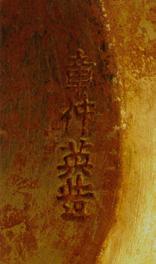
Fluted gold cup, Yuan dynasty; diameter: 7.8cm, height: 2.5cm. Excavated from Hefei city, Anhui province, Anhui Museum. Anhui province.
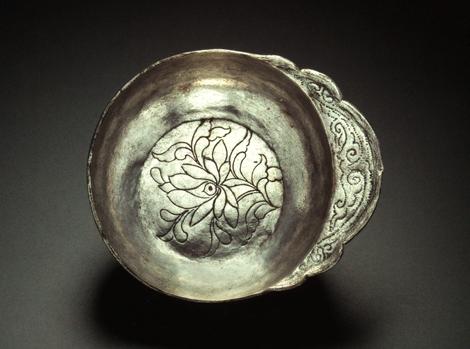
Fig. 7
Silver cup with chased and punched motifs Jin/Yuan dynasty; diameter: 10.2cm. After Sotheby’s, London, Masterpieces of Chinese Precious Metalwork , Early Gold and Silver , 14 May 2008.

Fig. 9
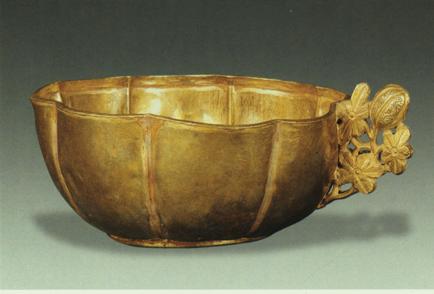
8
Fluted gold cup with a fruit- and flower-shaped handle, Yuan dynasty; diameter: 7.0cm. Excavated from a Yuan cellar hoard, Chujiaqiao, Taoshui, You county, Hunan province. Zhuzhou Museum, Hunan province.
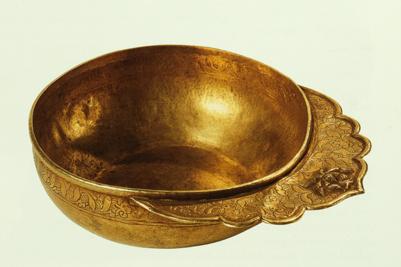
Chased gold cup, 13th century; diameter: 11.0cm. The State Hermitage Museum, St Petersburg. Fig. 10
Chased gold cup, 13th century; diameter: 14.5cm. The State Hermitage Museum, St Petersburg.
a crescent-shaped thumb-rest chased with scrolls and was probably once inlaid with precious stones, while the well is decorated with a medallion encircled by a decorative band (fig. 9). The second, dated to the thirteenth to fourteenth century, was found in a burial in the district of Verneskii, Semirech’e province in 1892. It has a floral band below the exterior rim and a flanged thumb-rest with a chased and repoussé design of lotus and other flowers (fig. 10). Notably, the thumb-rest comes to a point in an arch or ogee shape, unlike the present example which has more of a rounded, scalloped shape.
The same exhibition included another cup, this one of gilded silver, elaborately decorated with repoussé designs, with a central flowerhead surrounded by roundels containing lotus and ducks on the exterior, another roundel in the well and flowers on the thumb-rest, dated to the thirteenth century. This cup was found before 1876, at the Irtysh River, Tobolsk Governorate, east of the Urals, and is now in the State Hermitage Museum. 17
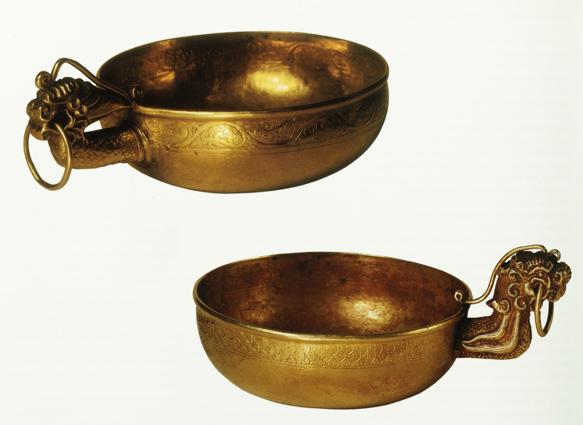
Fig. 11 (top image)
Gold cup with a dragon handle, 13th century; diameter: 13.0cm. The State Hermitage Museum, St Petersburg.
Fig. 12
Gold cup with a dragon handle, 13th century; diameter: 12.5cm. The State Hermitage Museum, St Petersburg.
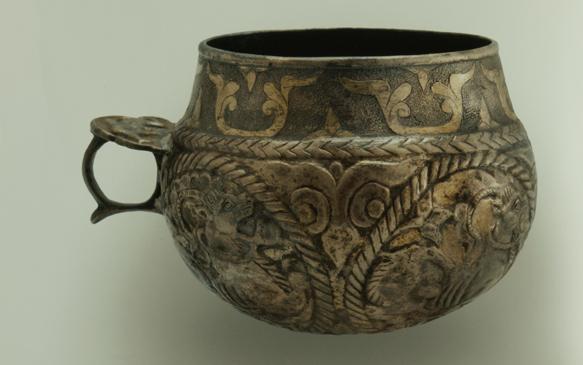
Fig. 14
8th century, Ancient Sogdiana, Central Asia; width: 12.0cm. The State Hermitage Museum, St Petersburg. Photo© The State Hermitage Museum.
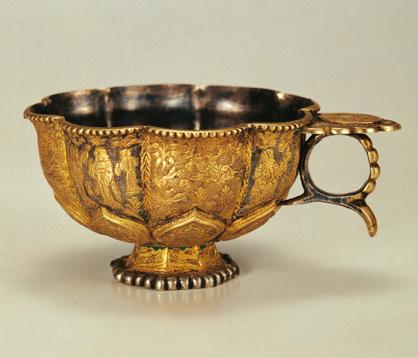
Fig. 13
Silver-gilt cup with thumb-rest and ring handle, Tang dynasty; diameter: 9.0cm. Excavated in Hejiacun, Xi’an. Shaanxi History Museum, Xi’an, Shaanxi province.

Fig. 15
Large silver cup with parcel gilding 8th century, Tibetan period, Northwestern China; width: 14.9cm. The Metropolitan Museum of Art, New York. Purchase, Pat and John Rosenwald and The Dillon Fund Gifts, and Rogers and Louis V. Bell Funds, 2001.
Two gold cups dated thirteenth century, with flat bases and dragon head handles (but without thumbrests) were also in the same exhibition, both now in the collection of the Hermitage (figs. 11 and 12). Both were also assigned to the Golden Horde, one found in Siberia and the other found near GasunUsta, Stavropol Governorate. 18 These ‘dragon-handled’ cups are often referred to as ‘belt bowls’. Clearly, the ring handle suspended from the dragon’s mouth on this variant would have been particularly convenient if the cup were hung from a belt as part of the trappings such as used by nomadic steppe tribes.
This group of cups found in the area controlled by the Golden Horde is interesting in that all bear some similarities to the present cup, as well as having some of their own distinct features. Although the finer details of the finds are not necessarily available, the dating of all these vessels to the thirteenth and fourteenth century indicates that they should be considered in parallel with the ones that have been more recently excavated in China cited above. Regardless of geography, whether they were found in China or in the region of the Golden Horde, the shape of this low, flat-bottomed cup was clearly favoured across the vast regions ruled by the Mongols from the twelfth to the fourteenth centuries.
Possible early prototypes
Although there seems little doubt that the present cup more likely belongs to the Xixia, Jin or Yuan period, rather than the Song, the origins of the shape is little researched, except suggestions that it most likely entered the Chinese metalwork repertoire from northernly steppe or Central Asian regions. Not only is the shallow form on a flat base atypical of Chinese metalwork, the additions of the flanged thumb-rest,
ring handle and indeed, on the other examples, the dragon-headed handle are design features which seem to have been drawn from external sources.
To begin with, it is also worth briefly considering the pre-existing metal working tradition in China before the arrival of the Mongols. Already, centuries earlier, during the Tang period, a rich and distinctive metalworking style had developed, reaching its height around the eighth century. Most of the objects were luxury items made for the elite – dishes and cups for banquets and presentation. The metalwork of the Tang is distinguished by elements – both shape and designs – which were drawn from Central Asia, Iran and other areas to the west of China.
With regards to the present gold cup, a metalworking innovation in China which dates from the eighth century or earlier was the addition of a ring handle and in some cases, a small volute thumb-rest, to drinking cups and goblets of various shapes. On the majority of Tang metal cups, the ring handle, if present, was soldered onto an escutcheon which was then riveted to the cup. Some of the ring handles also featured leafy tendrils, the use of the organic motif being perhaps a Sinicization of a western feature. A few of these Tang drinking cups, including lobed and octagonal examples, also featured larger thumbrests above the ring handles (fig. 13). 19
Vessels of Sasanian and Sogdian origin have been found in archaeological excavations in China. While some objects may have been imported or brought as diplomatic gifts into China along the silk roads, many Sasanian and Sogdian silversmiths also moved to China, from the time of the Muslim conquest of Persia, around the first half of the seventh century and were active in the imperial and government workshops. Discussion often revolves around whether some Central Asian metalworking features were borrowed by Chinese craftsmen or made by Central Asian craftsmen working in China; it is possible it was a combination of both. For a consideration of Sogdian metalworking influence on Tang metalwork, refer to a discussion by Qi Dongfang. 20 A digital exhibition at the National Museum of Asian Art, Washington D. C., The Sogdians, Influencers on the Silk Road , has also sought to distinguish Sogdian metalwork from Sasanian and considered Sogdian vessels in relation to Chinese metalwork. 21 Of particular interest here is the eighth century, rounded, flat-based cup of chased, engraved and gilded silver, decorated with goats in four large roundels and a thumb-rest decorated with two wrestlers, above a ring handle. It was found at the Don River, near Azov in Russia and acquired by The State Hermitage Museum, St Petersburg in 1927 (fig. 14). 22 This cup has been identified as being of Sogdian manufacture, with its shape borrowed from Turkish metalwork and likely intended for a Turkic patron. This and other Sogdian metal forms would not only have been familiar to Tang audiences but would also have been familiar to the nomadic peoples of the steppes.
Of course, the types of metalwork known in Tang China and later was not limited to Sogdian pieces and certainly Sasanian and other types of metalwork from western regions would also have been important sources of design. Low cups of this form with a handle and supporting thumb-rest also feature in metalwork from Iran, such as, for instance, a tenth-century bronze cup in the Ashmolean 23 and a later thirteenth-century inlaid bronze example of similar form, in a private Swiss collection. 24 Also relevant is a larger bowl of this low shape with a foot-ring and thumb-rest and ring handle, made of silver with parcel-gilt decoration and dated to the eighth century, now in The Metropolitan Museum of Art, which is identified as having been produced in Tibet (fig. 15). The Tubo people of the Tibetan-Qinghai plateau area, roughly contemporaneous with the Tang, were also famous for their distinct metalworking, which incorporated steppe traditions with Central Asian cultural references. The field is currently underresearched but their contribution in this context should be considered. 25
Thus, while there does not appear to be an exact, obvious and direct lineage for the present gold cup with its flat base and flanged thumb-rest and ring handle, when the Mongols first ruled in China, they would certainly have encountered some familiar metal shapes, with elements that had already been taken from Central and West Asian and Tibetan metalworking in previous centuries, starting from the Tang period. In addition, they would have also brought, not only their appreciation of fine metalwork in precious materials, but also their own tradition of drinking cups, drawn from the steppe cultures and metalworking regions along the silk roads.
Aside from the thumb-rest and ring handle – an innovation from western regions, which has now been considered, this shape of low-sided, flat-based drinking cup is something that is certainly distinctly different from other shapes within the Chinese metalworking tradition with the traditional foot-ring or stem. As mentioned, this form, or variants of it, is also sometimes referred to as a belt bowl – that is, an accessory to be hung from the belt, along with other belt trappings essential to a nomadic culture. The form is an indication of its design as a practical, portable item, to be used while travelling across great distances on horseback. The shallow, bowl shape would have allowed it to be cupped in one hand and the ring handle and thumb-rest were also practical, offering extra grip, for vessels to be used outdoors or even while riding. The ring handle would also have enabled it to be hung from a belt. Even more practical were the versions with dragon-headed handles with hanging loops.
A number of these cups with dragon-headed handles were found in the Western Eurasian steppe area that was controlled by the Mongols of the Golden Horde as cited above. Their popularity reached its height between the twelfth and fourteenth centuries, and it seems likely that this form would have been made across different regions with many local manufactories and variations, as may be seen from this belt cup from the Khalili collections, dated thirteenth or early fourteenth century, and assigned simply to
the Golden Horde, South Russia or Central Asia (fig. 16); the note on it is worth quoting in full:
A conspicuous element of the uniform of high Mongol cavalry officers was their belt trappings, which included a cup of precious metal with a handle in the form of a dragon’s head, a motif the Mongols had adopted from the Northern Song dynasty when they overran China. Such cups have been excavated over a vast geographical area, from northern China in the east to the fortress of Shumen in Bulgaria in the west, but with a concentration in the lands controlled by the Golden Horde. The earliest of them, a find in the province of Tobol’sk in Siberia, is dated 617 AH (1221 - 1222 AD), but they continued to be made, with local variations, well into the 14th century across the territories of the Mongol empire, gradually assimilating the styles of Near Eastern silversmiths. 26
From the discussion above, it seems likely that this form of drinking cup, with its roots in steppe culture, with design elements also derived from Central and West Asia, was found in various versions, made by different workshops, across the far-flung parts of the wider Mongol empire. However, the delicate, almost dainty appearance of the present cup with the gently lobed, fine, flanged thumb-rest and intricate, chased decoration suggest it was made in Yuan China for use by the ruling classes, the Mongol workmen incorporating a known shape with ‘Chinese’ design sensibility.
Once this shape had entered the Chinese metalwork repertoire and was made in valuable metals like gold and silver, the ways these cups were likely employed gradually changed and developed. Rather than for horseback use, for instance, they may have been re-purposed for more sedentary high-status banquets, either for drinking from directly or, alternatively, they might have been used as a scoop to draw wine out of a larger communal vessel from the centre of a table or perhaps had a ceremonial or ritual use. The form may simply have been retained as a symbolic reminder of historic nomadic traditions or rituals, rather than dictated by practical function any longer. In any case, the cultural reference of the shape was clearly an important factor in its use and continuance during the Yuan period. References to their Mongol traditions and trappings of their Mongol past was still deeply important and politically significant to the khans as they ruled China and embraced its culture.
Some clues may be gleaned from mural paintings on the interior of Yuan tombs which often depict vessels used in a formal or ritual arrangement, although this would presumably have varied by region and by the ethnicity and beliefs of the occupants. A fascinating insight is offered by the set of Yuan murals unearthed in Dongcun, Yangquan city, Shanxi province in 2012 and now in the Shanxi Museum. 27 A series of rectangular murals from this tomb is helpful in showing a wide variety of vessel types being used in three slightly different settings. One of the murals, on the north-west wall, depicts attendants preparing and serving food and wine. Another, on the north-east wall, shows attendants preparing tea, with bowls on raised cup-stands and tea pots. On the north wall, and central to this discussion, are the husband and wife occupants of the tomb, both accompanied by attendants, seated formally on either side of a table with a centrally positioned ancestor tablet (fig. 17). Behind the man, is a red lacquer table with the accoutrements of the scholar’s desk, including ink brushes and books. Behind the woman, is another red lacquer table ritually set with vessels for serving wine. These include a meiping , two yuhuchunping bottles, a large serving bowl with a ladle and smaller bowls. In addition, there is a yi vessel with a pouring spout and a low shallow cup with what appears to be a flanged thumb-rest (top right-hand side of the table on the left), very close in shape to the present vessel. The cup in the mural is painted in white, suggestive of a vessel of either silver or porcelain. Further behind the table are two large wine vats. The elaborate arrangement on the table, including the cup with flange, would suggest the latter was used during the Yuan period as part of a complex set of vessels with different functions, but all intended for serving and drinking wine in a formal, if not ritual, context.
Ceramic examples
As already discussed, few examples of these bowls in gold survive. However, the popularity of the shape is seen in its transfer to ceramics made during the same period. This shallow cup shape with a flat base, flanged thumb-rest and ring handle seems to have been made by a range of kilns, many in north China, mostly around the Jin and Yuan dynasties. Examples include a version from the Yaozhou kilns, now in the Yaozhou Ware Museum (fig. 18); one from the Ding kilns (fig. 19) and another from the Jun kilns (fig. 20), the last two now in the National Palace Museum, Taipei. In the case of these ceramic examples cited, the diameter of the vessels are relatively large and the thumb-rests and ring handles have become much smaller and less functional. It is unlikely that the ring handles alone would have supported the weight of these vessels, if indeed a finger could fit through them. The original form of the cup has therefore moved one step further from its original use, where not just the context for the vessel has changed, but also, some of the non-traditional metalwork features are no longer functional, and perhaps have been adopted for their novel decorative value.
Conclusion
The gold cup in this present exhibition has been assigned various dates over the last century, from the Tang to the Song dynasty, as different scholars have struggled to fit it into the traditional Chinese metalworking repertoire. However, its unusual shape and non-traditional metalwork features suggest that
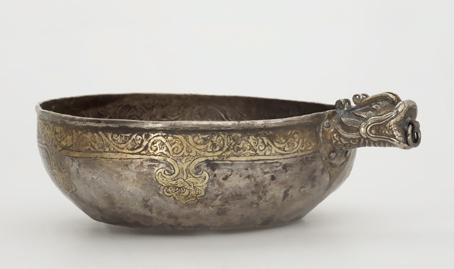
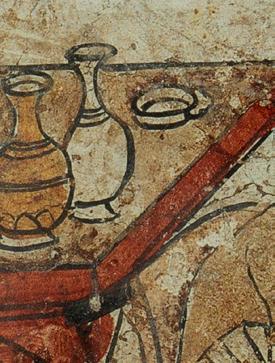
Fig. 17
Fig. 16
Silver and parcel-gilt belt cup with dragon handle, late 13th or early 14th century, Golden Horde (South Russia or Central Asia); 4.8cm x 16.0cm. The Khalili Collection.

Tomb mural unearthed in Dongcun, Yangquan city, Shanxi province in 2012, Yuan dynasty; length: 126.0cm. Shanxi Museum, Shanxi province.
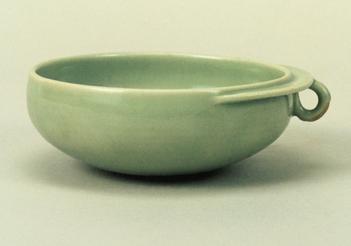
Fig. 18
Celadon-glazed stoneware cup with ring handle, Yaozhou kilns, Shaanxi province, Jin dynasty, 12th century; diameter: 15.4cm, height: 6.0cm. Yaozhou Ware Museum, Shaanxi province.
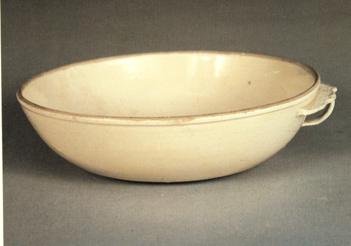
Fig. 19
Glazed stoneware cup with ring handle Ding kilns, Hebei province, Northern Song dynasty; diameter: 16.9cm. National Palace Museum, Taipei.
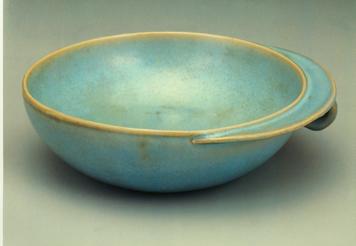
20
Blue-glazed stoneware cup with ring handle, Jun kilns, Henan province, Jin to Yuan dynasty; diameter: 17.4cm. National Palace Museum, Taipei.
it needs to be re-considered in the light of more recent archaeological finds in China. A brief comparison with similar gold examples excavated in China suggest that a Xixia, Jin or Yuan dating to around the twelfth to thirteenth centuries is more likely. A broader survey of the whole group of vessels – with some variants within them – suggest that this shape was popular and used widely across the vast Mongol empire over an extensive period. As different examples are considered, the variety and permutations of them emerge, all indicating the co-existence of different manufacturing centres.
The present cup combines the features of this specific shape with what appears to be Chinese decorative motifs and sensibility, thereby embodying the confluence of numerous cultural references in one vessel. The form, likely a familiar and long-known one, may have been either adopted or adapted by the Yuan Mongol elite as a potent cultural reference to their nomadic and steppe cultures. Further adaptation and adoption of these features may be seen in the contemporaneous ceramic versions from some northern Chinese kilns where form comes to dominate function. Alongside this, the function of these vessels clearly evolved, as supported by evidence from tomb paintings, from a practical, humble cup, to one that played a central role in a formal or ritualistic setting and had a particular position within the hierarchy of drinking and serving vessels in Yuan China.
Notes
1 Nick Pearce, ‘Ton-Ying and Co.’, see, https://carp.arts.gla.ac.uk/essay/?enum=1096638570 , accessed 21/07/2025.
2 H. Scott, The Golden Age of Chinese Art: The Lively Tang Dynasty , Tokyo, 1966, page 49, number 12.
3 P. Singer, Early Chinese Gold & Silver , China Institute in America, New York, 1971, page 68, number 98.
4 Rose Kerr, Chinese Art and Design , London, 1991, page 174, number 78; see also Susan Whitfield, The Silk Road: Trade, Travel, War and Faith , London, 2004, page 239, plate 169.
5 Chen Xiejun, Wang Qingzheng ed., Treasures on Grassland, Archaeological Finds from the Inner Mongolia Autonomous Region , Shanghai, 2000, page 252.
6 Nanjing Museum ed., The Golden China, Gold Artifacts of Ancient China , Nanjing, 2013, page 248, lower image.
7 James C. Y. Watt, The World of Khubilai Khan, Chinese Art in the Yuan Dynasty , New York, New Haven and London, 2010, page 6, figure 4.
8 Ibid., figure 5.
9 China Grand Canal Museum ed., Dadu, The Great Capital of the Yuan dynasty , Nanjing, 2023, page 254, top image.
10 B. Gyllensvärd, Chinese Gold and Silver in the Carl Kempe Collection , Stockholm, 1953, number 136; also, The Museum of Art and Far Eastern Antiquities in Ulricehamn, Chinese Gold and Silver in the Carl Kempe Collection , Ulricehamn, 1999, number 138.
11 China Grand Canal Museum ed., op. cit., page 254, lower image.
12 Refer to Sarah Wong and Stacey Pierson, Collectors, Curators and Connoisseurs: A Century of the Oriental Ceramic Society 1921 – 2021 , London, 2021, number 77.
13 Gyllensvärd, op. cit., number 53 A.
14 Yang Zhishui and Chen Jianming ed., The Discovery and Research on Gold and Silver Wares Unearthed from Caches of Song and Yuan Dynasty in Hunan , Beijing, 2009, page 240, top image.
15 Wang Yi ed., Golden Memories, Gold Wares Prior to the 14 th Century Unearthed in China , Chengdu, 2019, pages 288 - 289 for two Yuan examples.
16 Dschingis Khan und seine Erben, Das Weltreich der Mongolen , Bonn and Munich, 2005, numbers 254 and 256. See also, https://depts.washington.edu/silkroad/museums/shm/shmmongol.html , accessed 11/07/2025.
17 Ibid, number 258. See also, https://depts.washington.edu/silkroad/museums/shm/shmmongol.html , accessed 11/07/2025.
18 Ibid, numbers 250 and 251.
19 Han Wei ed., Tangdai jinyinqi (Gold and Silver of the Tang Dynasty), Beijing, 1985, numbers 58 and 59 for an eight-lobed silver cup decorated with figures of women and hunters and numbers 62 and 63 for an octagonal gold cup both excavated from Hejia village, southern suburbs of Xi’an. See also, Qi Dongfang, Tangdai jinyinqi yanjiu , (Research on Tang Gold and Silver), Beijing, 1999, colour plates 10 and 6 respectively.
20 Qi Dongfang, op. cit., pages 306 - 310.
21 https://sogdians.si.edu/sidebars/sogdian-metalworking/ , accessed 11/07/2025.
22 Exhibition catalogue, Expedition Silk Road, Journey to the West, Treasures from the Hermitage , organized by the State Hermitage Museum and Hermitage Amsterdam, Amsterdam, 2014, page 208, number 142. See also, https://sogdians.si.edu/cup-with-goats/ , accessed 11/07/2025.
23 https://jameelcentre.ashmolean.org/collection/921/per_page/100/offset/0/sort_by/size/start/899/ end/981/object/11068 , accessed 17/07/2025.
24 Michael Vickers, Oliver Impey and James Allan, From Silver to Ceramic , Oxford, 1986, plate 72.
25 Huo Wei, ‘The Mengdiexuan Collection of Tubo (Ancient Tibetan) Gold and Silver’ in Jenny F. So, Radiant Legacy, Ancient Chinese Gold from the Mengdiexian Collection , volume II, Hong Kong, 2013, pages 1531.
26 https://www.khalilicollections.org/collections/islamic-art/islamic-art-belt-cup-with-dragon-handlemtw1388/ for a discussion, accessed 15/07/2025. See also https://depts.washington.edu/silkroad/ museums/shm/shmmongol.html for the varied finds of such metalwork cups across the former Russian Empire, accessed 11/07/2025.
27 China Grand Canal Museum ed., op. cit., pages 237 - 243.
Chen Xiejun, Wang Qingzheng ed.: Treasures on Grassland, Archaeological Finds from the Inner Mongolia Autonomous Region , Shanghai, 2000.
Dschingis Khan und seine Erben, Das Weltreich der Mongolen , Bonn and Munich, 2005.
Expedition Silk Road, Journey to the West, Treasures from the Hermitage , organized by the State Hermitage Museum and Hermitage Amsterdam, Amsterdam, 2014.
Gyllensvärd, B.: Chinese Gold and Silver in the Carl Kempe Collection , Stockholm, 1953.
Han Wei and Deydier, C.: Ancient Chinese Gold , Paris, 2001.
Han Wei ed.: Tangdai jinyinqi (Gold and Silver of the Tang Dynasty), Beijing, 1985.
https://depts.washington.edu/silkroad/museums/shm/shmmongol.html , accessed 11/07/2025.
https://sogdians.si.edu/sidebars/sogdian-metalworking/ , accessed 11/07/2025.
https://www.khalilicollections.org/collections/islamic-art/islamic-art-belt-cup-with-dragon-handle-mtw1388/ , accessed 15/07/2025.
Marshak, B. and Kramarovsky, M. ed.: Treasures from the Ob’ Basin , St Petersburg, 1996. Museum Rietberg ed.: Chinesisches Gold und Silber; Die Sammlung Pierre Uldry , Zürich, 1994.
Nanjing Museum ed.: The Golden China, Gold Artifacts of Ancient China , Nanjing, 2013.
The Museum of Art and Far Eastern Antiquities in Ulricehamn: Chinese Gold and Silver in the Carl Kempe Collection , Ulricehamn, 1999.
Wang Yi ed.: Golden Memories, Gold Wares Prior to the 14 th Century Unearthed in China , Chengdu, 2019. Watt, J. C. Y.: The World of Khubilai Khan, Chinese Art in the Yuan Dynasty , New York, New Haven and London, 2010.
Whitfield, S.: The Silk Road: Trade, Travel, War and Faith , London, 2004.
Yang Zhishui and Chen Jianming ed.: The Discovery and Research on Gold and Silver Wares Unearthed from Caches of Song and Yuan Dynasty in Hunan , Beijing, 2009.
China Grand Canal Museum ed.: Dadu, The Great Capital of the Yuan dynasty , Nanjing, 2023.

图1

金錾刻鋬耳杯,西夏,金或元,公元12世纪—13世纪;宽:11.4厘米,口径:9.4厘米,高:2.9厘 米。本图录第8号展品。

图2
金錾刻杯,元;口径:7.0厘米,高:4.0厘 米。维多利亚与阿尔伯特博物馆,伦敦,M.301935。购藏经费由艺术基金会、瓦朗坦遗赠、 斐西瓦乐·大维德爵士及大学中国委员会共同 资助。

图4
金錾刻杯,元;宽:17.9厘米。出土于锡林郭 勒盟正蓝旗五一牧场。内蒙古博物院,呼和浩 特。
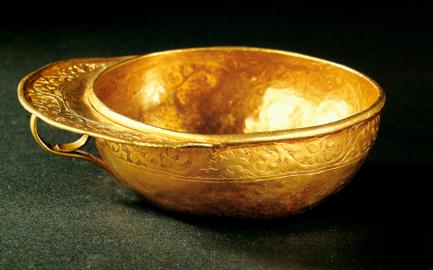
图3
金錾刻杯,元;宽:12.0厘米,高:5.0厘 米。1976年出土于内蒙古兴和县五股泉乡五甲 地村。内蒙古博物院,呼和浩特。

图5
花瓣形金錾刻杯,元;口径:8.9厘米。内蒙古 博物院,呼和浩特。见于James C. Y. Watt, 同前引,New York, New Haven and London, 2010。
莲纹金鋬耳杯
王嘉慧
这件引人注目的金鋬耳杯是约十二至十三世纪中国北方地区黄金工艺的稀有典范。然而其 独特的器型——平底浅腹的杯体、花瓣形板沿指垫、下接环形柄——明显不同于同时期的 典型金属器(图1,图录编号8)。与经典中国酒器或茶具不同,它既无高足亦无圈足。本 文将尝试从制作年代及地域两个角度为其定位。文章将对比相似及关联器物,探讨可能的 器型来源,最终阐释其文化意涵、用途及其在同时期中国陶瓷器中的映射。
这只金鋬耳杯于二十世纪初的收藏史脉络清晰(见本图录第50页)。最早记录显示它曾由 著名实业家、国民政府官员兼古董商张人杰(1877—1950,又名张静江)收藏。其创办 的通运公司曾在巴黎、上海和纽约都设有分号。 1 根据Nick Pearce的研究,张氏约在二 十世纪初通过其在中国的广泛人脉网络直接购得此杯:
张氏凭借其在中国政商界的影响力,能直接获得包括清宫旧藏在内的顶级艺 术品。其在巴黎时期结识的密友李石曾于1925年出任新成立的故宫博物院理 事长,负责清点清宫藏品。1933年日军侵占东北后,张氏还参与督导了过半 故宫文物南运上海的工作。
此后,长岛著名慈善家和收藏家克里斯蒂安·R·霍姆斯夫人(1871—1941)可能从 通运公司纽约分号直接购得此杯。她位于长岛桑兹角的宅邸“烟囱屋”曾藏有大量顶级中 国青铜器、陶瓷器与玉器,多数于1941年散出。
此杯后由宾夕法尼亚州共和党众议员兼参议员休·斯科特(1900—1994)收藏。这 位政治家以收藏唐代(618—907)艺术品著称。其著作《中国艺术的黄金时代:盛世大 唐》刊录了此杯,并将其断代为“唐(或宋早期)”。 2
斯科特曾多次将此杯借给美国境 内的重要展览,包括1971年于纽约华美协进社举办的具有开创意义的《早期中国金银器》 大展。 3 自此次展览起,经Paul Singer重新考证,此杯的年代已被修正为宋代(960— 1279),不再是唐代。
在中国传统金属器中,平底浅腹、带板沿指垫、下接环形柄的金杯存世极少。这类器 物可能仅为少数权贵特制,加之贵金属易被熔铸的特性,能够历经数百年保存至今者寥寥 无几。维多利亚与阿尔伯特博物馆现藏一件与之高度相似的金杯,原属乔治·尤摩弗帕勒 斯(1863—1939)旧藏,现被断代为元代(1271—1368)(图2)。 4 该杯内壁錾刻莲 纹,月牙形(非花瓣形)板沿饰经典卷草纹。与本文所述金杯素面抛光的外壁不同,此例 口沿处饰有锦纹。与此同时,二者口沿和板沿边皆有凸棱。
第二件同器型金杯同样被断代为元代,1976年出土于内蒙古兴和县五股泉乡五甲地 村,现藏于内蒙古博物院(图3)。 5 此件金杯亦带月牙形指垫,下方接环形柄并有一指 鋬。杯外壁近口沿处及板沿皆錾刻传统卷草纹,杯沿与板沿边均有凸棱。
第三件高度相似的金杯同样被断代为元代,出土于锡林郭勒盟正蓝旗五一牧场,现藏 于内蒙古博物院(图4)。此杯与前述内蒙古博物院藏例造型极为接近,惟环形柄未设指 鋬。其月牙形指垫上錾刻精美的双龙戏珠纹样,杯心饰狮子戏珠图,口沿则在双弦纹间饰 经典卷草纹。 6
这类器型中一件尤为精美的变体是一只金杯或金碗,亦是平底,带板沿指垫和环形 柄,与前述金杯类似,但器身及口沿均为花瓣形(图5)。 7 此件曾于2010年大都会艺术 博物馆《忽必烈的时代:元代中国艺术》特展展出,现藏内蒙古博物院。该杯指垫亦有纹 饰,口沿处在双弦纹间錾缠枝花纹。正如James Watt所述,这类器皿“源自游牧文化, 长期流行于中国北方,当为西夏党项人使用”。同展还呈现了一件西夏时期(1038— 1227)的花式金杯(现藏内蒙古博物院),虽无指垫及环形柄,但配有相应花式盏托,形 成独特组合。 8
与本文金鋬耳杯相关联的另有一件元代金把杯,平底,瓜棱形腹,方唇外突,器身 其余部分则光素无纹(图6)。其把手造型较为特殊:为方茎平把,下方带弧形柄。该杯 铭“章仲英造”四字款识,出土于安徽省合肥市一处孔庙遗址地基中。此批元代窖藏共出 土金银器102件,涵盖11种不同器型。 9
最后需提及同类器型的银杯——同样为平底、带板沿指垫及环形柄。其中一件著名例 子出自卡尔·肯普旧藏,被断代为金代(1115—1234)或元代,然其具体出土地点已无 从考证。此银杯杯心錾刻单朵莲花,指垫或以传统点錾技法饰点状卷草纹(图7)。 10
综上所述,随着考古发现不断丰富学界对唐代金属器的认知,此金鋬耳杯的断代经历 了逐步修正的过程:二十世纪初曾被归为唐代,后调整为宋代。参考二十一世纪出土的更 多类似器物,我们有必要对其制作年代进行更为审慎的考辨。近期出土的同类器物多属西 夏、金或元代,而非宋代。因此,该杯更准确的断代当属十二至十三世纪,即西夏、金或 元时期。
其他变体器型
尽管受篇幅所限无法详述,但本文仍将探讨一下其他十二至十四世纪所制,与本杯相关联 而又有差异的平底浅腹贵金属杯。
其中一种被称为“匜”的器皿亦是平底浅腹,但一侧增设流口,有时下方残留环形柄 痕迹,却无指垫。 11 元代景德镇曾大量烧造青花瓷匜,同时期的其他窑场则烧制过釉里 红瓷匜。 12 显然,带流的设计使匜的功能区别于本文讨论过的鋬耳杯,更可能用于倾倒 酒液而非用于直接饮用。
另一种出自同时期的变体亦无板沿指垫及环形柄,但配有龙首形短柄,龙口常衔圆 环。此类器型既有平底式,亦有带圈足式——如卡尔·肯普旧藏的一件。 13 平底版本多 见于钦察汗国统治区域,下文将专门探讨。
还有一类平底贵金属杯亦无指垫,但配有花形或果形柄。这种将植物造型融入把手的 做法或可视为外来器型本土化的表现。现藏株洲博物馆,于湖南攸县桃水镇褚家桥出土的 元代金单耳瓜杯即为一例(图8)。 14
最后需提及元代素面金杯——它们平底浅腹,无指垫及环形柄,通体光素无纹,仅于 杯心錾刻铭文。 15
考古发现与最新研究均表明,这些变体器型亦多属金元时期。这进一步佐证:本文讨 论的金鋬耳杯虽仍可断代为十二至十三世纪,但其具体定位应修正为西夏、金或元时期, 而非宋代。
钦察汗国地区杯器
与本文所述金鋬耳杯及前文讨论过的出土器物密切相关的,还有一批在蒙古帝国钦察汗 国(术赤兀鲁思)统治过的欧亚草原西部地区发现的器皿。这批器皿与本品形制极为相 似——皆具平底浅腹的基本特征,带花瓣形或月牙形指垫,下方附环形柄。现有多件藏于 圣彼得堡艾尔米塔什博物馆,其中不少系十九世纪俄罗斯考古队于前俄罗斯帝国边疆地区 挖掘所得。
特别值得注意的是两件浅腹金杯,均在2005—2006年《成吉思汗及其继承者》特展 中展出过,现藏艾尔米塔什博物馆。
16
其中一只被断代为十三世纪,1845年出土于梅利 托波尔托盘尼村附近的一处古墓。其月牙形指垫錾刻卷草纹,可能曾镶嵌宝石,杯心饰卷 枝纹一周(图9)。另一只被断代为十三至十四世纪,1892年发现于谢米列奇耶省维尔涅 斯基区的一处墓葬(图10)。此杯口沿下方饰花卉纹带,板沿指垫以錾刻锤揲工艺饰莲花 及其他花卉。值得注意的是,其指垫呈尖拱形,异于本杯指垫的花瓣形造型。
同展另见一件十三世纪鎏金银杯,通体锤揲精美纹饰:外壁中心饰花卉一朵,环绕莲 鸭纹圆形开光,杯心及指垫皆饰花卉。此杯于1876年前发现于乌拉尔以东托博尔斯克省额 尔齐斯河流域,现藏艾尔米塔什博物馆。 17
展览另包含两件十三世纪金杯,平底浅腹,带龙首柄,但无指垫,现皆藏于艾尔米塔 什博物馆(图11、12)。它们亦属钦察汗国遗存,一件发现于西伯利亚,另一件发现于斯 塔夫罗波尔省加孙-乌斯塔附近。 18 这类“龙柄杯”常被称为“腰带碗”。显然,其龙口 衔环的设计便于游牧民族悬挂于腰带。
这批钦察汗国辖域出土的杯器具有重要文化意义:它们既与本文探讨的金鋬耳杯存在 明显亲缘关系,又具有自身特色。尽管部分器物的具体信息已不可考,但其十三至十四世

图6

瓜棱形金把杯,元;口径:7.8厘米,高:2.5厘米。出土于安徽省合肥市。 安徽博物院,安徽省。

图7
银錾刻杯,金/元;口径:10.2厘米。见于
Sotheby’s, London, Masterpieces of Chinese Precious Metalwork, Early Gold and Silver, 14 May 2008。

图9
金錾刻杯,公元13世纪;口径:11.0厘米。
艾尔米塔什博物馆,圣彼得堡。

图8
金单耳瓜杯,元;口径:7.0厘米。出土于湖南 省攸县桃水镇褚家桥。株洲博物馆,湖南省。
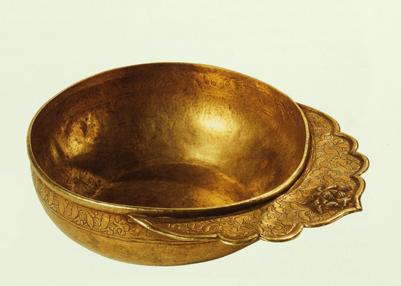
图10
金錾刻杯,公元13世纪;口径:14.5厘米。 艾尔米塔什博物馆,圣彼得堡。

图11
金龙首柄杯,公元13世纪;口 径:13.0厘米。艾尔米塔什博物 馆,圣彼得堡。
图12
金龙首柄杯,公元13世纪; 口径:12.5厘米。艾尔米塔 什博物馆,圣彼得堡。

图14
鎏金錾刻银杯,公元8世纪,古粟特,中亚;宽:12.0厘米。艾 尔米塔什博物馆,圣彼得堡。图片版权© 艾尔米塔什博物馆。

图16

图13
银鎏金杯,带指垫和环形柄,唐;口径:9.0 厘米。出土于西安何家村。陕西历史博物馆, 陕西省西安。

图15
银胎局部鎏金碗,公元8世纪,吐蕃,中国西 北部;宽:14.9厘米。大都会艺术博物馆, 纽约。2001年购藏,资金由帕特与约翰·罗 森瓦尔德夫妇和狄龙基金,及罗杰斯与路易 斯·V·贝尔基金共同提供。
银胎局部鎏金龙首柄腰带杯,公元 13世纪晚期或14世纪早期,钦察汗 国(南俄或中亚地区);4.8x16.0 厘米。卡里利收藏。
纪的断代,为前文所述中国境内近年出土的同类器物形成了有力的参照。无论是发现于中 国还是钦察汗国疆域,这种平底浅腹的带把杯在十二至十四世纪蒙古帝国的广袤版图内显 然备受推崇。
早期原型探微
尽管此金鋬耳杯出自西夏、金或元时期而非宋代几乎已毋庸置疑,但关于其造型渊源的学 术探讨仍显不足。目前学界普遍认为,这种器型很可能是从北方草原或中亚地区传入中国 金属工艺谱系。其平底浅腹的基本造型明显有别于中原传统器型,板沿指垫、环形柄或龙 首柄等装饰元素亦带有外来文化特征。
首先有必要简短阐述蒙古入主中原前中国的金属工艺传统。早在数个世纪前的唐代, 中国就已发展出丰富独特的金属工艺体系,并在八世纪前后达到鼎盛。这些用于宴饮或陈 设用的盘与杯多是为宫廷贵族特制的奢侈品。唐代金属器的独特之处,正在于其从造型到 纹饰都吸收了来自中亚、伊朗及其他西域地区的元素。
就本文所述金鋬耳杯而言,中国金属器在八世纪甚至更早便已出现一项重要创新:为 各类饮杯添加环形柄,有时还配以蜗形小指垫。唐代金属杯的环形柄多通过以下工艺固 定:先焊接于垫片,再铆接于器身。值得注意的是,部分环形柄上饰卷草纹,可能为西域 元素的中原化。此类唐代饮杯有的为花瓣形或八棱形,有的更在环形柄上方配设了较大的 指垫(图13)。 19
中国考古发掘中屡见萨珊与粟特金银器皿。这些器物有的是通过丝绸之路的贸易或外 交馈赠传入中原。另一方面,自七世纪上半叶波斯被穆斯林征服后,曾有大量萨珊与粟特 银匠迁居中华,供职于宫廷和官府作坊。学界常探讨唐代金属器中的中亚工艺特征究竟是 中国匠人借鉴所得,还是由在华中亚匠人直接制作——亦或是二者兼而有之。齐东方曾详 论粟特金属工艺对唐代的影响。 20 而华盛顿国立亚洲艺术博物馆的数字展览《粟特人: 丝绸之路上的影响者》亦尝试将粟特金属器与萨珊金属器区分开来,并探讨了前者与中 国金属器的关联。 21 其中特别值得关注的是一件八世纪鎏金錾刻银杯,平底圆腹,外壁 四面开光内饰山羊纹,指垫上饰摔跤手一对,下带环形柄(图14)。 22 此杯出土于俄罗 斯顿河近亚速海区域,后于1927年入藏圣彼得堡艾尔米塔什博物馆。研究确认其为粟特 制品,造型借鉴突厥金属器风格,可能为某突厥贵族定制。此类粟特器物不仅为唐人所熟 知,也深受草原游牧民族的青睐。
当然,唐代以降中国人所接触到的金属器远非限于粟特制品,萨珊王朝及西域其他地 区的金属工艺同样是重要灵感源泉。此类带指垫与柄的浅腹杯造型亦见于伊朗金属器,如 牛津大学阿什莫林博物馆所藏的一件十世纪青铜杯, 23 及瑞士私人收藏的一件十三世纪 镶嵌青铜杯。
24 另见纽约大都会艺术博物馆所藏的一件八世纪银胎局部鎏金碗,浅腹、 带圈足、指垫与环形柄,经鉴定为吐蕃制品(图15)。与唐代并存的青藏高原吐蕃人,其 独特金属工艺以融合草原传统与中亚文化元素而著称。尽管对该领域的研究尚显薄弱,但 其在跨文化传播中的贡献应予以充分关注。 25
由此可见,尽管本文所述金鋬耳杯的造型(平底,带板沿指垫及环形柄)尚无明确的 传承脉络,但当蒙古统治者初入中原时,他们必然遇见了已然熟悉的金属器型——这些器 物的造型元素早自唐代起便从中西亚及吐蕃金属工艺中汲取灵感。与此同时,蒙古人也将 其对精美贵金属器的审美爱好,以及受草原文明与丝路沿线金属工艺产区影响的独特饮器 传统带入了中原。
除却前文讨论过的源自西域的指垫与环形柄这两项创新,这种平底浅腹的饮杯造型本 身便与中国传统金属器中常见的圈足杯或高足杯存在本质差异。如前所述,此类杯形及其 变体常被称作“腰带碗”——即作为游牧文化中不可或缺的腰带佩饰组件而存在。其形制 设计凸显便携实用特性,适应鞍马劳顿的游牧生活需求。浅腹造型便于单手持握,环形柄 与指垫更增强户外骑行时持杯的稳定性。环形柄同时方便直接将杯悬挂于腰带之上。比这 还要更加实用的则是龙首衔环的杯柄设计。
前文已提及,有一批龙首柄杯出土于欧亚草原西部钦察汗国统治区。其鼎盛期集中 于十二至十四世纪,很可能由不同地域的作坊生产,呈现出丰富的造型嬗变。卡里利收 藏(Khalili Collections)中的一件“腰带杯”即为例证——该器被断代为十三或十 四世纪初,产地被归属为钦察汗国 (南俄或中亚地区)(图16);其藏品说明极具参考价 值,在此全文引用:
蒙古高级骑兵装束的显著标识是其腰带佩饰,其中便包括以龙首为柄的贵金属
饮杯(此为蒙古征服北宋后吸纳的中国元素)。此类饮杯出土地域横跨欧亚大陆,东起 中国北方,西至保加利亚舒门要塞,尤以钦察汗国故地最为集中。目前已知最早实例可 追溯至回历617年(公元1221—1222年),出土于西伯利亚托博尔斯克省。但这种杯型 一直到十四世纪仍在蒙古帝国全境被生产,各地作坊均有本土化的变体,同时其工艺逐 渐融合近东银器的特征。 26
功能探讨
综前所述,这种根植草原文化、融汇中亚与西亚设计元素的饮杯,产出于蒙古帝国广袤疆域内的不 同作坊,衍生出多元变体。然而本件金鋬耳杯所呈现的纤巧雅致之风——柔婉的花瓣形指垫、精美 的錾刻纹饰——显示其应是元代中原的产品,专供统治阶层使用。蒙古工匠在承袭传统器型的基础 上,为之注入了鲜明的“中国式”审美意趣。
这种器型融入中国金银器体系后,其使用功能应是逐渐发生演变。从马背上的移动饮杯,转化 为静态的高规格宴饮酒具——或用于直接饮用,或作为舀勺从餐桌中央的酒器中取酒,抑或服务于 礼仪祭祀。其基本原始形制得以保存,应更多作为游牧文化传统的载体,而非实际需求使然。无论 如何,在元代,这种造型蕴含的文化背景无疑是其被持续使用的重要原因。对统治中原并接纳汉文 化的蒙古可汗而言,所有带有蒙古族历史与传统印记的器物都具有深刻的政治意义。
元代墓葬内的壁画或可提供若干线索,这些壁画常描绘正式场合和仪式中使用的器皿——尽管 具体陈设方式可能因地域、墓主族属及信仰差异而有所不同。2012年出土于山西省阳泉市东村,现 藏于山西博物院的一组元代墓室壁画极具启发意义。 27
该墓室中一系列壁画生动展现了三种不同场 景中的多种器皿:西北壁的一幅壁画描绘侍从备办膳食与奉酒;东北壁的一幅壁画表现侍者备茶, 可见置于盏托上的茶盏及茶壶。而位于北壁的一幅壁画则对本文的讨论尤为关键,描绘了墓主夫妇 在随侍陪同下正襟危坐于供桌两侧,桌面中央供奉祖先牌位(图17)。墓主身后设红漆桌,陈列包 含毛笔在内的文房用具及书籍;其夫人后方另置红漆桌,仪式化地摆放着一系列酒具。其中包括一 只梅瓶、两只玉壶春瓶、大型酒碗及瓢、还有数只小盏。此外,可见一只带流口的匜,以及一只平 底浅腹杯(位于左侧供桌右上方),该杯带有明显的板沿指垫,其造型与本文所述金杯极为相似。
壁画中此杯施白色,暗示其材质为银器或瓷器。供桌后方更陈列两尊大型酒瓮。整套精心布置的器 皿组合(含带板沿的杯)表明:此类杯盏在元代是一整套功能各不相同的酒具的组成部分,用于正 式场合和仪式上的宴饮。
陶瓷鋬耳杯例子
如前文所述,此类黄金材质的鋬耳杯存世数量极少。然而同时期的陶瓷制品印证了该器型的流行程 度。这种平底浅腹、带板沿指垫及环形柄形制的杯形似乎曾在中国北方多个窑口烧造,主要集中于 金元时期。实例包括一件耀州窑月白釉鋬耳洗,现藏耀州窑博物馆(图18);一件定窑单把杯(图 19);和一件钧窑天青釉单把洗(图20),后两者现藏台北故宫博物院。这些陶瓷实例的直径相 对较大,而指垫与环形柄则显著缩小,且功能性减弱。即使手指真能穿过这些环形柄,仅凭把手本 身也难以支撑器物的重量。由此可见,这些杯子的形制已脱离其原始用途——不仅使用情境发生改 变,某些源自异域金属器的造型特征也不再具有实用功能,或许仅因其装饰性而被保留。
结语
本次展出的莲纹金鋬耳杯在过去百年历经多次断代更迭——从最先的唐代到后来的宋代,诸名学者 曾试图将其纳入中国传统金属器谱系而不可得。鉴于其独特的形制与非传统的金属工艺特征,我们 有必要结合中国近年的考古发现重新为其定位。对比中国国内出土的类似金器,我们推断该杯更可 能产自十二至十三世纪的西夏、金或元。通过参考同类器皿及其变体我们发现:这种器型在蒙古帝 国的广袤疆域内曾长期流行且被广泛使用。这些不同实例展现出的形制多样性与嬗变轨迹也意味着 曾有不同地域的作坊同时参与生产。
此件金鋬耳杯将独特的造型与具有中国审美特质的纹饰相结合,由此成为多元文化融合的象 征。它历史悠远且广为流传的器型,被元代蒙古统治阶层采纳并改造,成为指向其草原游牧文化 渊源的强力符号。同时期中国北方的一些窑场将此器型进一步改造——但在这些陶瓷版本的鋬耳杯 中,外观造型主导了实用功能。与此同时,正如元代墓室壁画所表现的那样,此类器皿的功能属性 也发生了显著变迁:从最初朴素的实用饮器,转变为在正式仪式场合承担核心职能的礼器,并在元 代中国酒器等级礼制中占据了特定地位。

图17

2012年出土于山西省阳泉市东村的墓室壁画,元;长:126.0厘米。山西博物院,山西省。

图18
月白釉鋬耳洗,耀州窑,陕西省, 金,公元12世纪;口径:15.4厘米, 高:6.0厘米。耀州窑博物馆,陕西 省。

图20
天青釉单把洗,钧窑,河南省,金至 元;口径:17.4厘米。故宫博物院, 台北。

图19
白釉单把杯,定窑,河北省,北宋; 口径:16.9厘米。故宫博物院,台 北。
1 Nick Pearce,‘Ton-Ying and Co.’,参见, https://carp.arts.gla.ac.uk/ essay/?enum=1096638570 ,accessed 21/07/2025。
2 H. Scott,The Golden Age of Chinese Art: The Lively Tang Dynast y, Tokyo,1966,49页,12号。
3 P. Singer,Early Chinese Gold & Silver,China Institute in Ameri ca,New York,1971,68页, 98号。
4 Rose Kerr,Chinese Art and Design,London,1991,174页,78号;亦参见,Susa n Whitfield,The Silk Road: Trade,Travel,War and Faith,London,2004 , 239 页,169号。
5 陈燮君、汪庆正主编,《草原瑰宝—内蒙古文物考古精品》,上海,2000,252页。
6 南京博物院编,《金色中国—中国古代金器大展》,南京,2013,248页,下图。
7 James C. Y. Watt,The World of Khubilai Khan,Chinese Art in the Yuan Dynasty,New York,New Haven and London,2010,6页,图4。
8 同上,图5。
9 中国大运河博物馆编,《大都:元代北京城》,南京,2023,254页,上图。
10 B. Gyllensvärd,Chinese Gold and Silver in the Carl Kempe Colle ction, Stockholm,1953,136号;亦参见,The Museum of Art and Far Eastern Antiq uities in Ulricehamn,Chinese Gold and Silver in the Carl Kempe Collect ion, Ulricehamn,1999,138号。
11 中国大运河博物馆编,同前引, 254页, 下图。
12 参见Sarah Wong and Stacey Pierson, Collectors,Curators and Conno isseurs: A Century of the Oriental Ceramic Society 1921—2021,London,2021 ,77号。
13 Gyllensvärd,同前引,53A号。
14 杨之水、陈建明主编,《湖南宋元窖藏金银器发现与研究》,北京,2009,240页,上图。
15 王毅编,《金色记忆—中国十四世纪前出土金器特展》,成都,2019,288—289页可见两件元 代例子。
16 Dschingis Khan und seine Erben,Das Weltreich der Mongolen,Bonn and Munich,2005, 254号和256号。亦参见, https://depts.washington.edu/silkroad/ museums/shm/shmmongol.html , accessed 11/07/2025。
17 同上,258号。亦参见, https://depts.washington.edu/silkroad/museums/shm/ shmmongol.html , accessed 11/07/2025。
18 同上,250号和251号。
19 韩伟主编,《唐代金银器》, 北京, 1985, 58和59号为一件仕女狩猎纹八瓣银杯, 62和63号 为一件八棱金杯,两件均出土于西安市南郊何家村。亦参见齐东方, 《唐代金银器研究》,北京 1999, 彩图10号和6号。
20 齐东方,同前引,306—310页。
21 https://sogdians.si.edu/sidebars/sogdian-metalworking/ ,accessed 11/07/2025。
22 Exhibition catalogue,Expedition Silk Road, Journey to the West ,Treasures from the Hermitage,organized by the State Hermitage Museum and Hermitage Amsterdam,Amsterdam,2014,208页,142号。亦参见, https://sogdians.si.edu/cupwith-goats/ , accessed 11/07/2025。
23 https://jameelcentre.ashmolean.org/collection/921/per_page/100/ offset/0/ sort_by/size/start/899/end/981/object/11068 ,accessed 17/07/2025。
24 Michael Vickers,Oliver Impey and James Allan,From Silver to Ce ramic, Oxford,1986,72号。
25 Huo Wei,‘The Mengdiexuan Collection of Tubo (Ancient Tibetan) Gold and Silver’ in Jenny F. So,Radiant Legacy,Ancient Chinese Gold from the Mengdiexian Collection,volume II,Hong Kong,2013,15—31页。
26 https://www.khalilicollections.org/collections/islamic-art/isla mic-artbelt-cup-with-dragon-handle-mtw1388/ for a discussion, accessed 15/07/2025。亦 参见, https://depts.washington.edu/silkroad/museums/shm/shmmongol.htm l ,可见前 俄罗斯帝国疆域内出土的多件此类金属杯出土实物, accessed 11/07/2025。
27 中国大运河博物馆编,同前引,237—243页。
参考文献
Chen Xiejun, Wang Qingzheng ed.: Treasures on Grassland, Archaeological Finds from the Inner Mongolia Autonomous Region, Shanghai, 2000.
Dschingis Khan und seine Erben, Das Weltreich der Mongolen, Bonn and Munich, 2005.
Expedition Silk Road, Journey to the West, Treasures from the Hermitage, organized by the State Hermitage Museum and Hermitage Amsterdam, Amsterdam, 2014
Gyllensvärd, B.: Chinese Gold and Silver in the Carl Kempe Collection, Stockholm, 1953.
Han Wei and Deydier, C.: Ancient Chinese Gold, Paris, 2001.
Han Wei ed.: Tangdai jinyinqi (Gold and Silver of the Tang Dynasty), Beijing, 1985.
https://depts.washington.edu/silkroad/museums/shm/shmmongol.html, accessed 11/07/2025.
https://sogdians.si.edu/sidebars/sogdian-metalworking/, accessed 11/07/2025.
https://www.khalilicollections.org/collections/islamic-art/islamic-art-belt-cup-withdragon-handle-mtw1388/, accessed 15/07/2025.
Marshak, B. and Kramarovsky, M. ed.: Treasures from the Ob’ Basin, St Petersburg, 1996.
Museum Rietberg ed.: Chinesisches Gold und Silber; Die Sammlung Pierre Uldry, Zürich, 1994.
Nanjing Museum ed.: The Golden China, Gold Artifacts of Ancient China, Nanjing, 2013.
The Museum of Art and Far Eastern Antiquities in Ulricehamn: Chinese Gold and Silver in the Carl Kempe Collection, Ulricehamn, 1999.
Wang Yi ed.: Golden Memories, Gold Wares Prior to the 14th Century Unearthed in China, Chengdu, 2019.
Watt, J. C. Y.: The World of Khubilai Khan, Chinese Art in the Yuan Dynasty, New York, New Haven and London, 2010.
Whitfield, S.: The Silk Road: Trade, Travel, War and Faith, London, 2004.
Yang Zhishui and Chen Jianming ed.: The Discovery and Research on Gold and Silver Wares Unearthed from Caches of Song and Yuan Dynasty in Hunan, Beijing, 2009.
China Grand Canal Museum ed.: Dadu, The Great Capital of the Yuan dynasty, Nanjing, 2023.
Chronology
Chinese Dynasties and Periods 中国朝代
Xia period
of Erlitou culture
Shang period
phase
Zhou period
Zhou
Zhou
and Autumn period
States period
dynasty
dynasty (Wang Mang)
1600c – 1027
Sui dynasty
581 – 618 Tang dynasty
618 – 907 Five dynasties
Liao dynasty
907 – 960
907 – 1125 Song dynasty
dynasty
– 1279
– 1127
1127 – 1279
1115 – 1234
AD 公元
Yuan dynasty 元 1271 – 1368
Ming dynasty 明 1368 – 1644
Hongwu
Jianwen
Yongle
Hongxi
Xuande
Zhengtong
Jingtai
Tianshun
Chenghua
Hongzhi
Zhengde
Jiajing
Longqing
Wanli
Taichang
Tianqi
Chongzhen
洪武 1368 – 1398
建文 1399 – 1402
永乐 1403 – 1424
洪熙 1425
宣德 1426 – 1435
正统 1436 – 1449
景泰 1450 – 1456
天顺 1457 – 1464
成化 1465 – 1487
弘治 1488 – 1505
正德 1506 – 1521
嘉靖 1522 – 1566
隆庆 1567 – 1572
万历 1573 – 1620
泰昌 1620
天启 1621 – 1627
崇祯 1628 – 1644
Qing dynasty 清 1644 – 1911
Shunzhi
Kangxi
Yongzheng
Qianlong
Jiaqing
Daoguang
Xianfeng
Tongzhi
Guangxu
Xuantong
Republic of China
顺治 1644 – 1661
康熙 1662 – 1722
雍正 1723 – 1735
乾隆 1736 – 1795
嘉庆 1796 – 1820
道光 1821 – 1850
咸丰 1851 – 1861
同治 1862 – 1874
光绪 1875 – 1908
宣统 1909 – 1911
中华民国 1911 – 1949
People’s Republic of China 中华人民共和国 1949 –
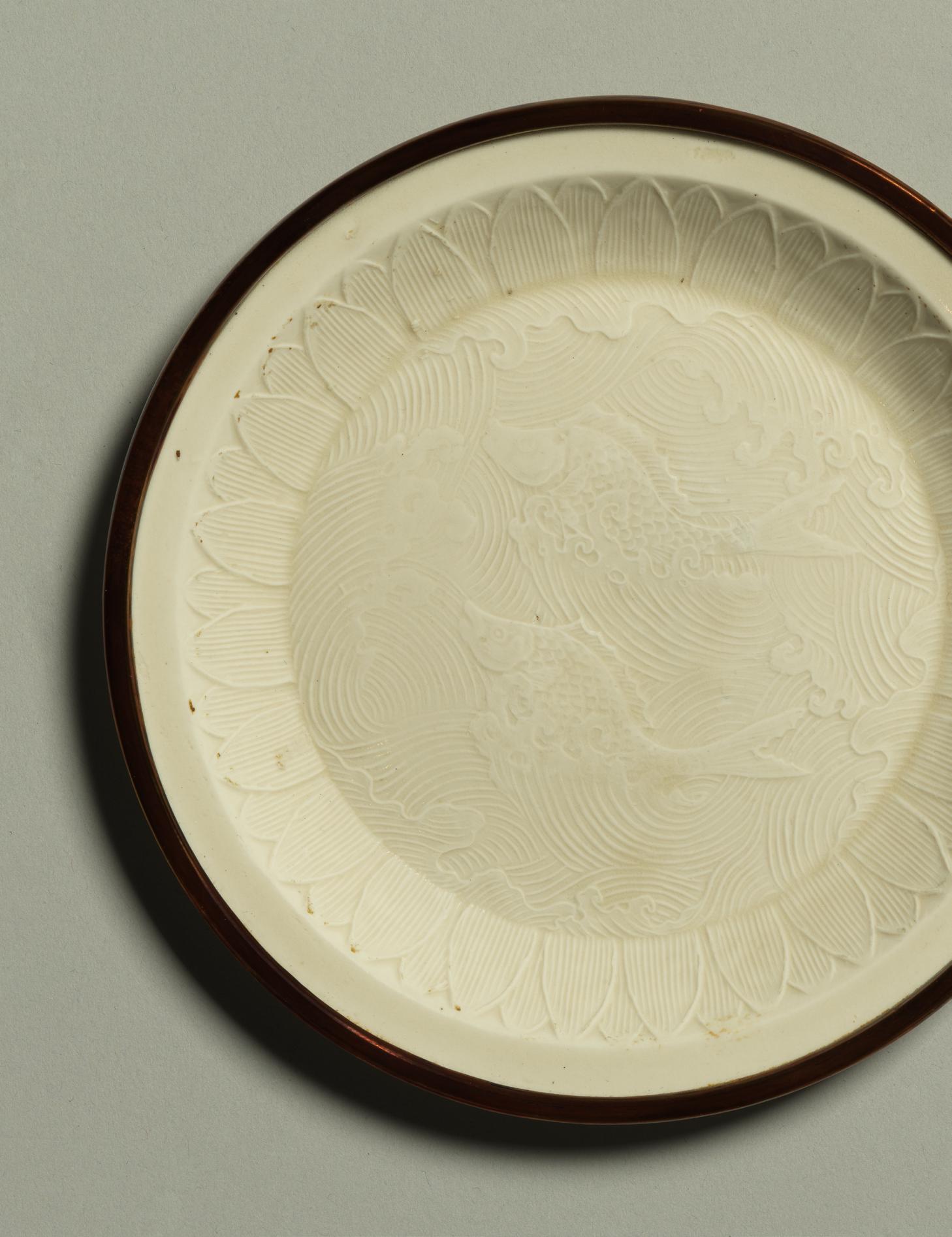

Chinese ceramics, metalwork and lacquer from the 12th to the 14th century
定 窑
河 北 省
Glazed porcellaneous stoneware dish with moulded and combed decoration
Northern Song or Jin dynasty, 12th - 13th century Ding kilns, Hebei province
Diameter: 14.8cm
Small glazed porcellaneous stoneware dish with a flat base and low sides rising to a flat everted rim with raised edge. The centre of the dish is crisply moulded with a pair of lively fish, each with well-defined scales and dorsal fin, swimming amid turbulent waves indicated by concentric combed lines and scalloped edges. A double petal lappet fills the cavetto. The dish is covered with an ivory-toned glaze, apart from the raised rim edge which is encircled by a copper band.
Similar examples:
Jan Wirgin, Sung Ceramic Designs , Stockholm, 1970, plate 61e and page 137 for an example in the Fitzwilliam Museum, Cambridge.
Margaret Medley, Illustrated Catalogue of Ting and Allied Wares , London, 1980, plate VI, number 47, London, 1980, for a dish of larger size with carved, incised and combed decoration in the Percival David collection (number 176); see also, Mary Tregear, Song Ceramics , Fribourg, 1982, page 58, number 37.
The motif of swimming fish is a recurrent one on Song ceramics and is found not only on the vessels of the Ding kilns, but also on Longquan, Yaozhou and Cizhou wares. Favoured for their auspicious associations, the word for fish ( yu ) is a homophone for wealth and they were also associated with harmony and conjugal bliss.
Fish were extremely popular as a decorative design on Ding wares, whether rendered as carved, incised or moulded decoration, or a combination of techniques and were found on dishes, bowls and deep basins of the twelfth and thirteenth centuries. They were variously depicted as swimming in the turbulent waves of the sea, as on the present dish, or among waterweeds or lotus plants in a duck pond. Occasionally a single fish was used to decorate the interior of a basin but, more usually, they are found in pairs, swimming either in the same or opposite direction, or in fours.
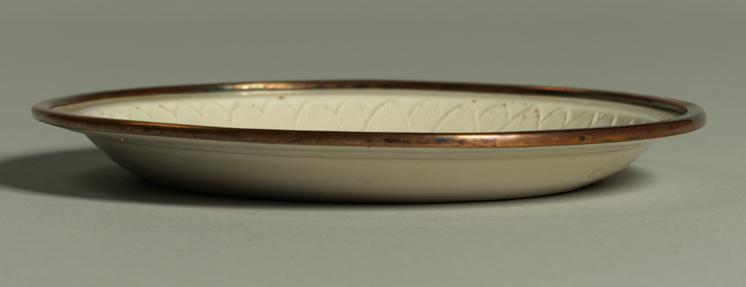

Glazed porcellaneous stoneware bowl with moulded decoration Northern Song or Jin dynasty, 12th - 13th century Ding kilns, Hebei province
Diameter: 15.5cm
Finely potted, glazed porcellaneous stoneware bowl of shallow conical shape, standing on a low foot-ring. The cavetto is crisply impressed with four multi-petalled chrysanthemum blooms, borne on slender stems and surrounded by scrolling foliage, beneath a narrow key-fret border. The well is decorated with a single flowerhead. The bowl is entirely covered with a characteristic ivory-coloured glaze, with typical olive-toned ‘tears’ on the exterior, apart from the rim, which is fitted with a gilt-metal band.
Provenance:
James K. Wetherly, Colorado.
Shimojo Art Co., Tokyo, c. 1980.
Marchant, London, until 2014.
Exhibited:
London, 2014, Marchant.
Published:
Marchant, Chinese Ceramics Tang to Qing , London, 2014, number 6.
Similar examples:
Jan Wirgin, Sung Ceramic Designs , Stockholm, 1970, plate 80b.
The Palace Museum, Selection of Ding Ware: the Palace Museum’s Collection and Archaeological Excavation , Beijing, 2012, number 68.
Li Huibing ed., Porcelain of the Song Dynasty (1) , The Complete Collection of Treasures of the Palace Museum, volume 32, Hong Kong, 1996, page 62, number 54, for an example with three blooms.
National Palace Museum, Decorated Porcelains of Dingzhou, White Ding wares from the collection of the National Palace Museum , Taipei, 2014, number II – 100 for an example with four chrysanthemum flowers and numbers II-101 and II-102 for bowls each with three.
This type of conical bowl, with moulded floral motifs in the cavetto below a key-fret border at the rim, appears in a range of sizes from around 15.5cm in diameter, as seen in the present example, to larger ones of around 20.3cm in diameter. On these bowls some designs have scrolling branches bearing four large chrysanthemum blooms, while others have three. Further examples are found with moulded decoration of pomegranate fruit and flowers.
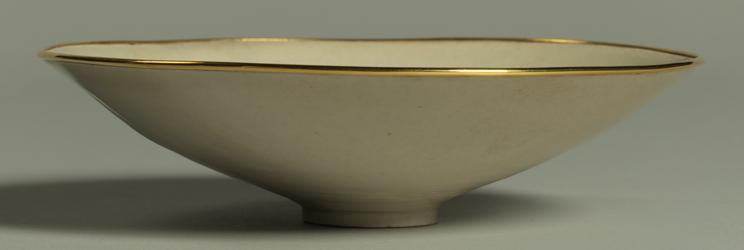
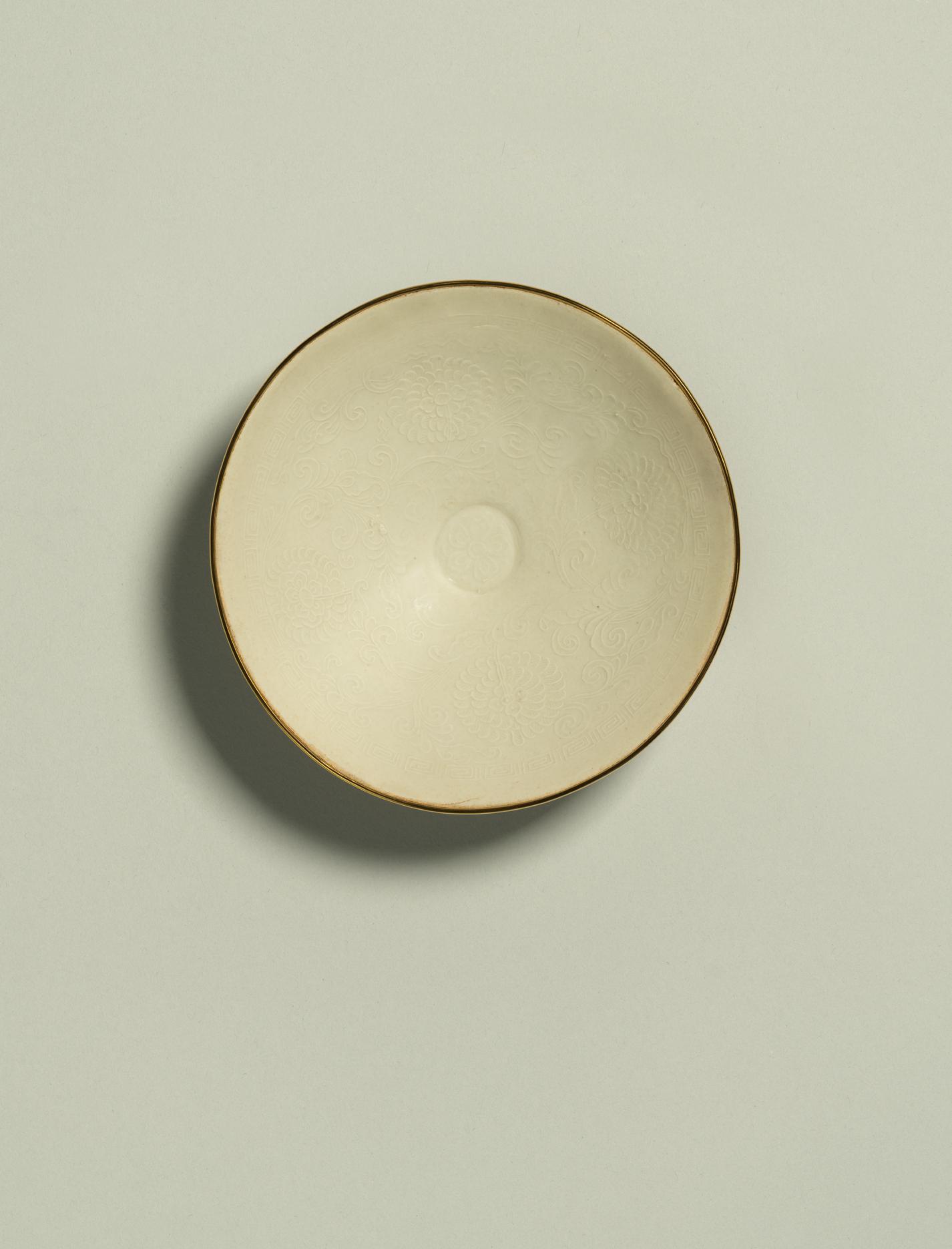
外 壁 素 面 无 纹 , 施 象 牙
碗 器 型 饱 满 ,
深 腹 ,
斜 弧 壁 , 下 承 刀 削 圈 足 , 口 沿 外 撇 作 六 曲 葵 口 。 内 壁 以 娴 熟 刀 工 刻 划 缠 枝 莲 纹 , 双 莲 怒 放 于 卷 叶 之 间 , 枝 叶 舒 卷 自 如 。
定 窑
河 北 省 口 径 二 十 五 . 八 公 分
三 白 釉 刻 花 大 碗 北 宋 公 元 九 六 〇 年 二 七 年
Large glazed porcellaneous stoneware bowl with carved decoration Northern Song dynasty, 960 - 1127 Ding kilns, Hebei province Diameter: 25.8cm
Well-potted deep bowl with rounded conical sides supported on a knifepared foot, rising to a flared rim with six notches. The interior is freely and superbly carved with two large lotus blooms and a broad leaf pad, all borne on scrolling stems. The bowl is covered with an ivory-coloured glaze pooling in characteristic teardrops on the plain exterior, apart from the unglazed lobed rim. The base is partially covered with a trace of glaze.
Provenance:
The Chang Foundation, Taipei.
The Le Cong Tang Collection, Taipei.
Exhibited:
London, 2021, Brunei Gallery, SOAS, University of London.
Published:
James Spencer (comp.), Selected Chinese Ceramics from Han to Qing Dynasties, Chang Foundation , Taipei, 1990, catalogue number 25.
Sotheby’s, Hong Kong, Song , Important Chinese Ceramics from the Le Cong Tang Collection , 3 October 2017, number 1.
Sarah Wong and Stacey Pierson ed., Collectors, Curators, Connoisseurs: A Century of the Oriental Ceramic Society , 1921 - 2021, London, 2021, number 58.
Similar examples:
Oriental Ceramics, The World’s Great Collections, The British Museum , volume 5, Tokyo, 1976, colour plate 26.
Li Huibing ed., Porcelain of the Song Dynasty (1) , The Complete Collection of Treasures of the Palace Museum, volume 32, Hong Kong, 1996, page 62, number 52.
Eskenazi Limited, Principal wares of the Song period from a private collection , London, 2015, number 3.

Ding ceramics, considered to be one of the ‘classic’ wares of the Song period, were made from around the ninth century, with the apogee of production between the eleventh and twelfth centuries; important kiln sites include Yanchuan/Yebei, Jianci and Beizhen villages in Hebei province. The present bowl is a superb example of pieces made at the height of the Ding kilns production and it is distinguished by its white body, fine potting and fluidly executed design. It is also notable for its large size, with related examples in museum and private collections ranging from around 21cm to 26cm in diameter.
The stylized lotus blooms on the present bowl are also a ‘design classic’. The lotus flower was a favourite Song subject, found in paintings, ceramics and the decorative arts of the period. The lotus motif had its roots in much earlier dynasties and is found carved and painted in Buddhist cave temples in China, such as at Yungang and Dunhuang, from the sixth and seventh centuries and indeed on Tang metalwork. However, the stylized qualities of the earlier representations – often as lotus scrolls or rosettes – gave way to a softer, more fluid rendition on Northern Song ceramics, as is evident on the present bowl.
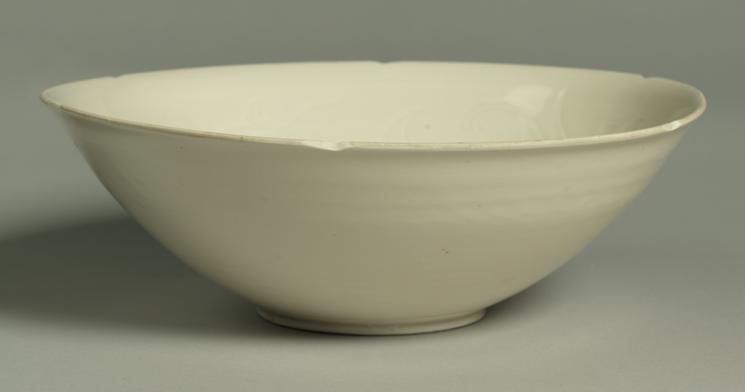

Green-glazed stoneware dish
Northern Song dynasty, 960 - 1127
Yaozhou kilns, Shaanxi province
Diameter: 17.9cm
Green-glazed stoneware ‘mallow’-shaped dish supported on a low footring, with angled sides flaring to a foliate rim. The cavetto is divided into six lobes by raised radial lines, with corresponding incised indentations on the exterior. A triple-line band encircles the exterior edge of the rim. The dish is covered all over with a lustrous olive-green glaze apart from the underside of the foot-ring which has fired to an orange-brown colour.
Similar example:
Rose Kerr, Yaozhou Wares from Museums and Art Institutes Around the World including Yaozhou Tribute Wares , Woodbridge, Suffolk, 2021, page 64, number 75 for an example in the Minneapolis Institute of Art.
This dish relies on shape and the rich olive glaze for its attractive decorative effect, without much further embellishment. The simple addition of radial lines enhances the lobed rim to produce the effect of a ‘mallow’ flower. It is relatively rare to find Yaozhou bowls and dishes that are undecorated – most are enhanced with incised or moulded decoration on the interior and often on the exterior as well. Such undecorated dishes relying on shape and glaze for their aesthetic appeal were also produced by the Ding kilns. See, for instance, two flowershaped Dingyao dishes with lobed rims, dated to the Northern Song dynasty, in the collection of the Palace Museum, Beijing. 1
1 The Palace Museum, Selection of Ding Ware: the Palace Museum’s Collection and Archaeological Excavation , Beijing, 2012, number 73 for a white-glazed example and number 89 for a persimmon-glazed example.
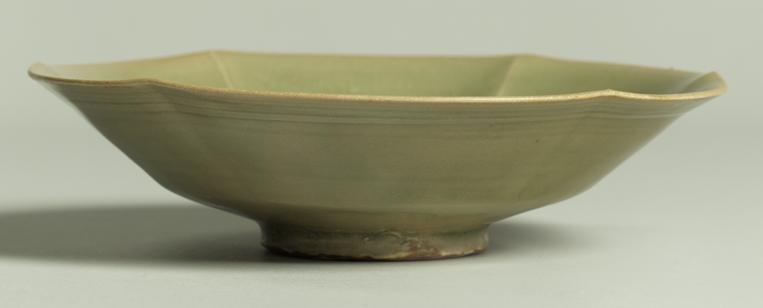

5
Pair of brown lacquer foliate dishes
Song dynasty, 960 - 1279
Diameter of each: 17.3cm
Pair of brown lacquer dishes, each supported on a low circular foot. The low sides of each terminate in a flared rim gently indented to form six lobes, bound with a thin copper band. The cavetto is separated into conforming lobed sections by six vertical raised ridges. Both dishes are covered all over with a lustrous chestnut-brown lacquer. The base of one dish is inscribed in red lacquer with a two-character mark which may be read as Bi Tian ( 碧天 ), probably a maker’s or collector’s mark. The base of the second dish bears an illegible three-character mark.
Provenance:
The Lee Family Collection, Tokyo.
Published:
Christie’s, Hong Kong, Important Chinese Lacquer from the Lee Family Collection , Part III , 28 November 2012, number 2081.
Similar examples:
Osaka Municipal Museum of Art, Sōgen no bijutsu (Arts of the Song and Yuan), (Chinese Art Exhibition Series 4), Osaka, 1978, page 58, number 3-3 and, also, number 3-2 for a smaller example.
Lee King Tsi and Hu Shih-chang, Dragon and Phoenix, Chinese Lacquer Ware , The Lee Family Collection , Tokyo , Cologne, 1990, page 60, number 15, for a similar dish from the same collection but bearing a different mark.
Hu Shih-chang and Jane Wilkinson, Chinese Lacquer , Edinburgh, 1998, page 23, number 3 for a similar dish bearing an illegible mark.
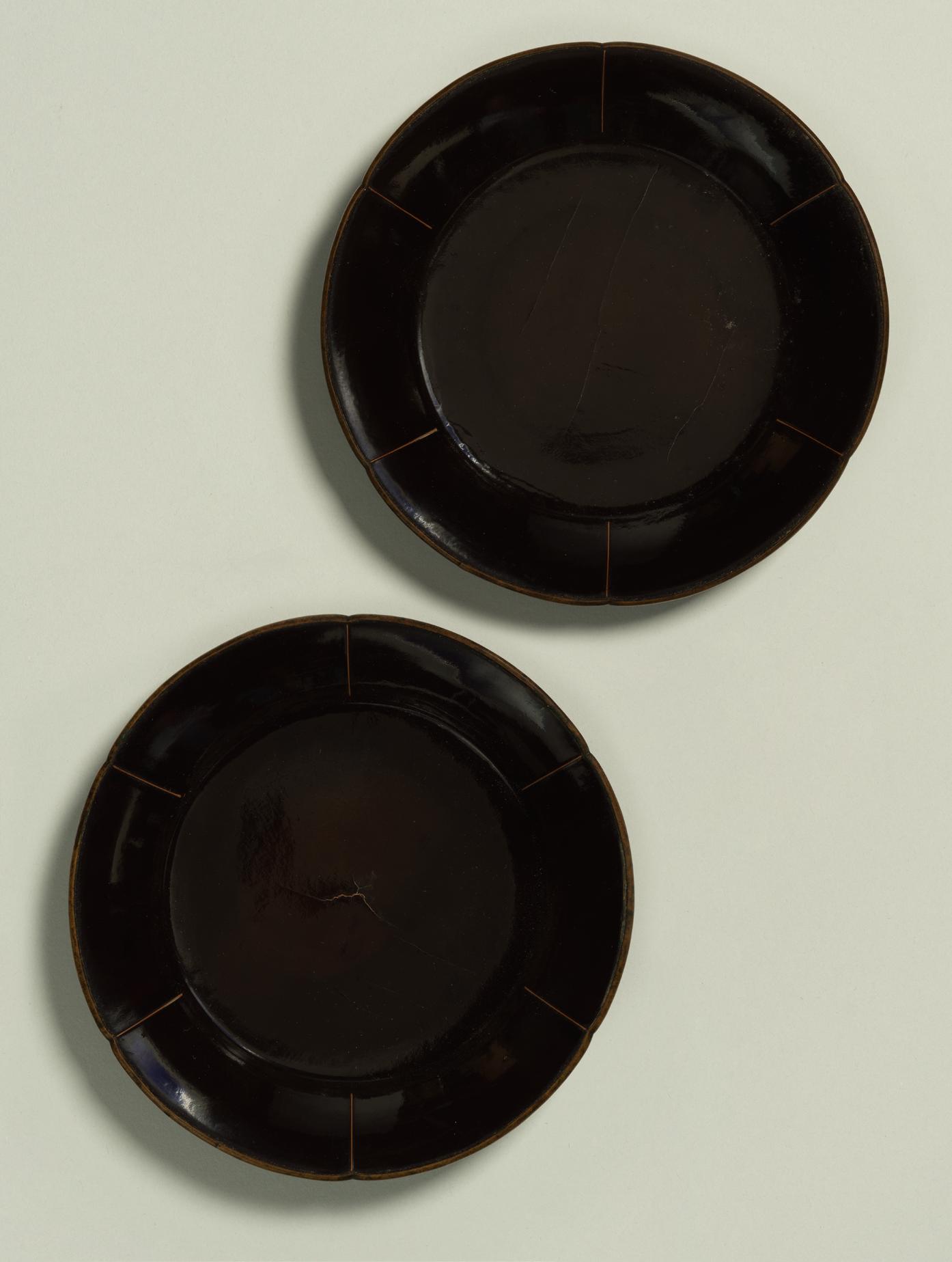
Black lacquer ‘mallow-shaped’ dish
Song dynasty, 960 - 1279
Diameter: 18.3cm
Black lacquer dish in the shape of a seven-petalled mallow flower, supported on a low foot-ring. The overlapping petals are divided by S-shaped ridges carved on the cavetto and the underside. The dish is covered with a lustrous blackish-brown lacquer on the interior and the exterior. The base is inscribed in light brown lacquer with a stylized shou character within a roundel.
Provenance:
Private collection.
Sir Joseph Hotung (1930 - 2021), London and Hong Kong.
Published:
Christie’s, Hong Kong, The Imperial Sale , Important Chinese Lacquer , Ceramics and Works of Art , 30 April 2001, number 621.
Sotheby’s, Hong Kong, The Personal Collection of the Late Sir Joseph Hotung , Part 1 (Evening) , 8 October 2022, number 18.
Similar examples:
Nezu Institute of Fine Arts, The Colors and Forms of Song and Yuan China, Featuring Lacquerwares, Ceramics and Metalwares , Tokyo, 2004, number 20 for a slightly larger example divided into seven ‘petals’.
Harry Garner, Chinese Lacquer , London, 1979, page 52, number 21 for a smaller example.
Osaka Municipal Museum of Art, S ō gen no bijutsu (Arts of the Song and Yuan), (Chinese Art Exhibition Series 4), Osaka, 1978, page 58, numbers 3-5 and 3-6 for two smaller examples.
James C. Y. Watt and Barbara Brennan Ford, East Asian Lacquer, The Florence and Herbert Irving Collection , New York, 1991, number 2 for a sixpetalled dish with a mark in the collection of the Metropolitan Museum of Art.
Dishes in the form of an open mallow flower, undecorated except for overlapping ‘petals’ formed by S-shaped ridges on the interior and exterior, are classic examples of Northern Song to Yuan lacquer. The curving S-shape of the overlapping petals lends these forms an elegant simplicity. Watt and Ford, cited above, suggest that the ‘rotating floral petals’ on such dishes may in fact be identified as ‘one of the great decorative motifs of the Yuan period.’
Examples of these lacquer dishes with both six petals and with seven petals are known 1 and variants are also found in red lacquer. Similar in design but less organic in appearance are lobed dishes with the cavetto divided by straight, rather than S-shaped lines. 2
This mallow flower shape is seen in both metalwork 3 and ceramics of the period, an example of the latter being a dish from the Ding kilns, now in the Percival David collection. 4
1 Osaka Municipal Museum of Art, Sōgen no bijutsu (Arts of the Song and Yuan), (Chinese Art Exhibition Series 4), Osaka, 1978, page 58, numbers 3-4, 3-5 and 3-6.
² Ibid., page 58, number 3-3.
3 Yang Zhishui et al., The Discovery and Research on Gold and Silver Wares Unearthed from Caches of Song and Yuan Dynasties in Hunan, Beijing, 2009, number 610 for a silver flower-shaped dish.
4 Stacey Pierson with S. F. M. McCausland, Song Ceramics, Objects of Admiration, London, 2003, number 31.
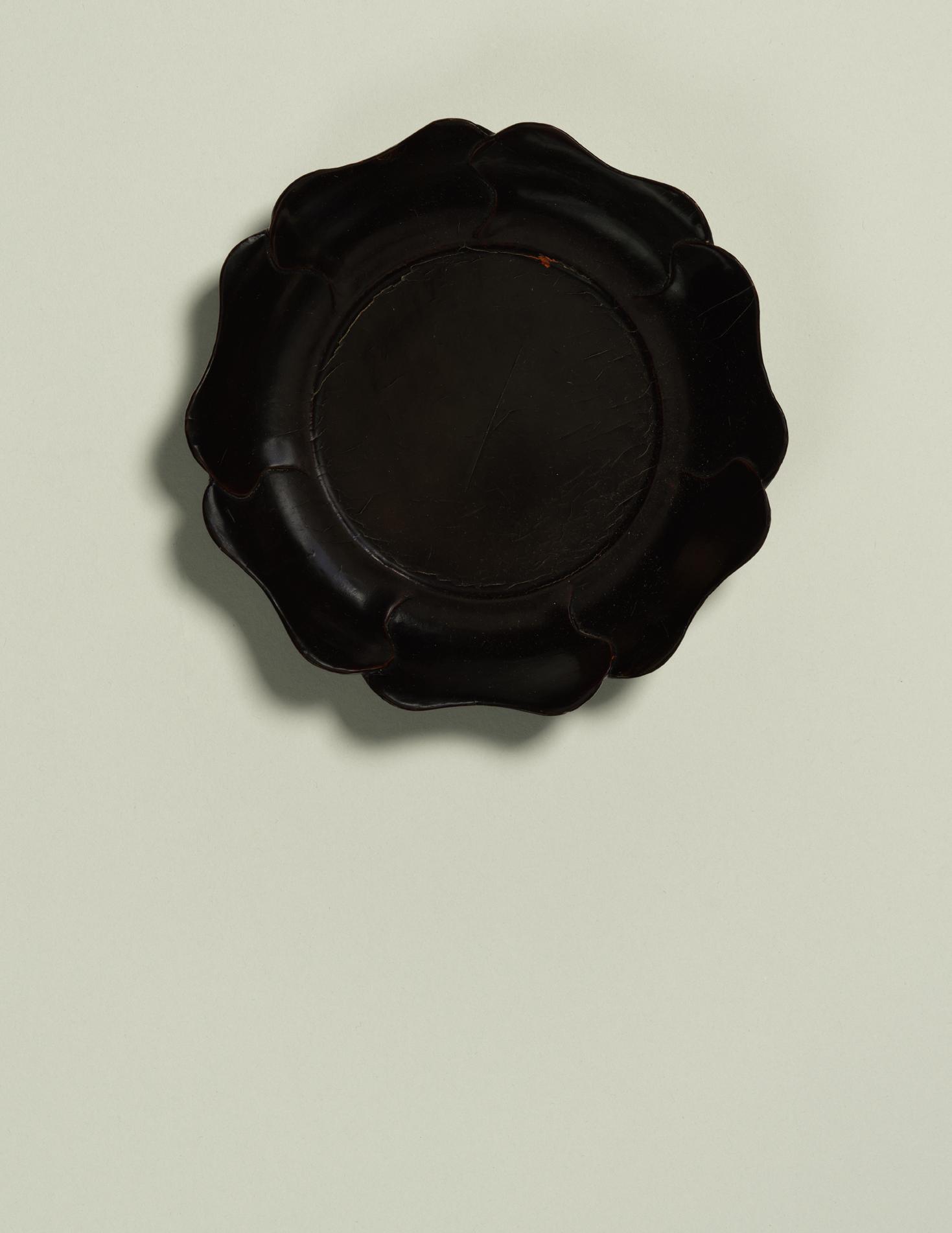

起 深 弧
壁 托 杯 。
通 体 以 黑
漆 为 底 ,
外 罩 朱 漆 , 历 经 岁 月 磨 蚀 后 大 多 已
露 出 底
层
黑 漆 ,
唯
托 杯 内 壁 与
承 盘
正
面 仍 保
存 浓 郁
朱 红
色
淌 至 足 上 方 。 烧 制 时 釉 料 垂 流 , 在 口 沿 铜 扣 下 方 露 出 赭 色 化 妆 土 。 圈 足 及 底 无 釉 , 呈 紫 褐 金 属 光 泽 。 盏 托 高 足 外 撇 , 六 曲 葵 瓣 形 承 盘 中 央
深 色 陶 胎 茶 盏 , 侈 口 , 深 腹 壁 , 口 沿 下 圈 微 束 , 矮 直 圈 足 。 外 施 蓝 黑 釉 , 釉 面 呈 细 密 赭 色 兔 毫 纹 , 盏 心 积 釉 处 呈 黑 褐 色 , 外 壁 不 规 则 流
Glazed stoneware ‘hare’s fur’ tea-bowl and a lacquer cup stand
Bowl: Southern Song dynasty, 1127 - 1279
Jian ware, from the kilns at Shuiji, Jianyang county, Fujian province
Diameter: 12.2cm
Stand: Probably Japanese, Edo period, 1603 - 1868
Diameter: 15.8cm
Height: 9.5cm
Well-potted dark stoneware tea-bowl with steep sides, indented below the rim, standing on a low, straight foot-ring. The bowl is covered in a lustrous ‘hare’s fur’ glaze of fine russet streaks against the blue-black ground, pooling thickly to solid black-brown in the well and falling in an irregular line short of the foot. During firing, the glaze has moved downwards, exposing the iridescent russet slip around the rim, which is encircled by a copper band. The unglazed foot and base have fired to a metallic purple-brown colour.
The high flaring foot of the lacquer stand supports a six-petalled mallow-form flange and a high-sided, rounded bowl holder. The stand has been lacquered red over a black underlayer, now mostly abraded to reveal the black underlayer, with the interior of the cup holder and the upper surface of the flange retaining a deep red tone.
Published:
调 。 | | | |
公 分 高 九 . 五 公 分
Sotheby’s, Hong Kong, Arcadian Beauty , 3 October 2018, number 3111.
Similar examples:
Bowl:
Sekai Toji Zenshu (Ceramic Art of the World), volume 12, Tokyo, 1977, page 254, numbers 253 and 254 for the example in the Tokyo National Museum.
Robert D. Mowry, Hare’s Fur, Tortoiseshell and Patridge Feathers, Chinese Brown- and Black-Glazed Ceramics, 400 – 1400 , Cambridge, Massachusetts, 1996, number 76.
Stand:
James C. Y. Watt and Barbara Brennan Ford, East Asian Lacquer, The Florence and Herbert Irving Collection , New York, 1991, number 74 for a version dated to the Muromachi period, 15 th - 16 th century.
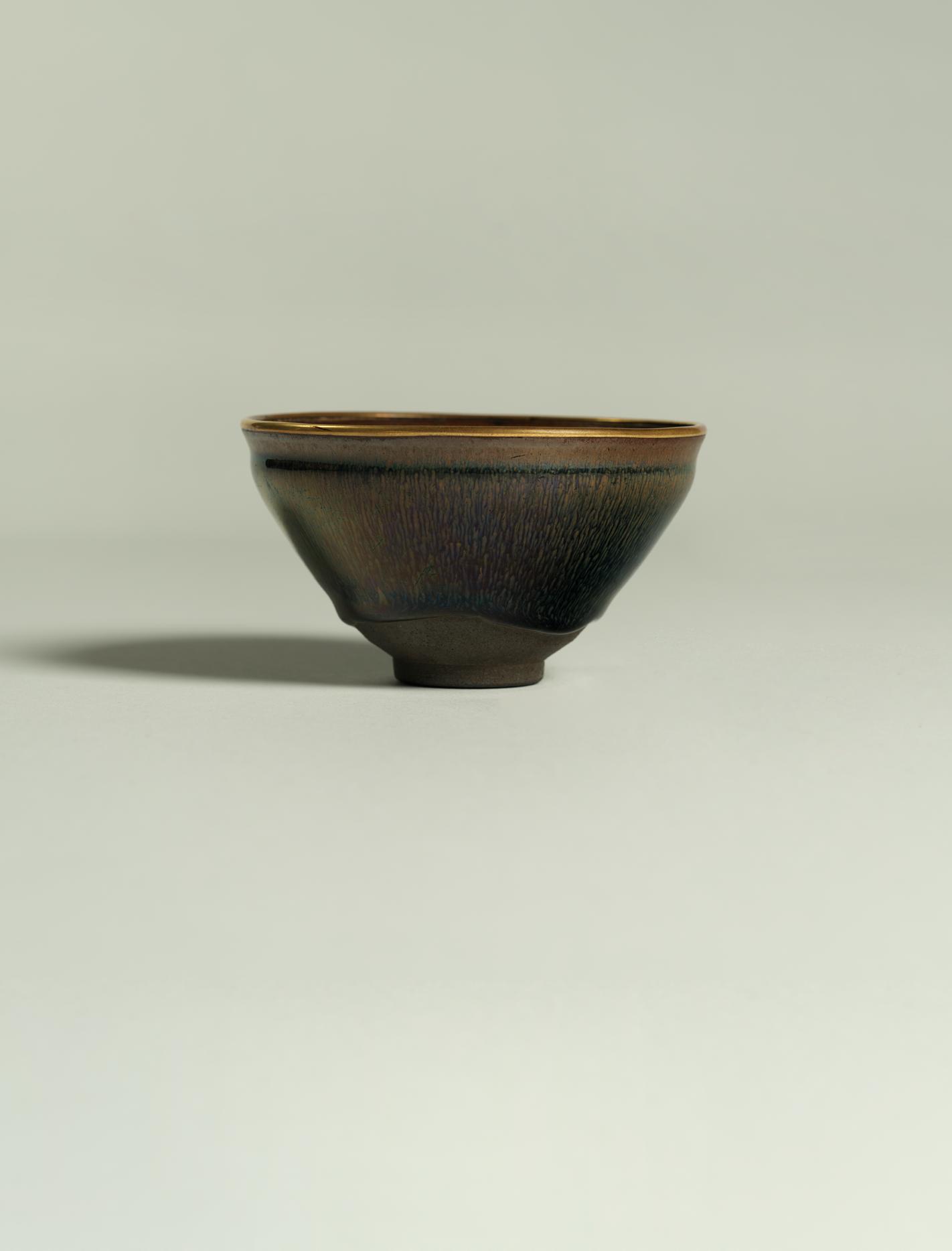


During the Northern Song period, the Jian kilns in Fujian province were celebrated for their dark-bodied tea bowls with glossy black-brown glazes, decorated with a variety of streaks and splashes, the most famous effects being known as ‘hare’s fur’ ( tuhao wen ), as seen on the present example, and ‘oil spot’ ( youdiyou ). In both cases, the striking surface effects were caused by a concentration of iron oxides which came to the surface during firing and crystallized as iron-rich minerals. Imperial patronage secured the position of Jian wares. The Emperor Huizong (r. 1100 - 1126) was known to favour Jian tea bowls and some wares were incised on the base with ‘for imperial use’ marks; those with hare’s fur streaks were declared to be the most desirable.
The dark-glazed tea bowls with hare’s fur glaze were referred to as nogime tenmoku in Japan, where they were also highly prized. Often paired with a lacquer stand ( tenmoku-dai ), of either Japanese or Chinese origin, they were used either ritually or in daily life, in monasteries, by tea devotees and in shogunal households.
The present bowl is paired with a stand that appears to be of a negoro lacquer type, named after the Negoro temple in Kii province, Honshu Island. These lacquer wares usually had a wood core which was painted with an underlayer of black lacquer and an upper layer of red lacquer. As the red layer wore away, it created a distressed patina of antiquity that was much appreciated by tea connoisseurs.

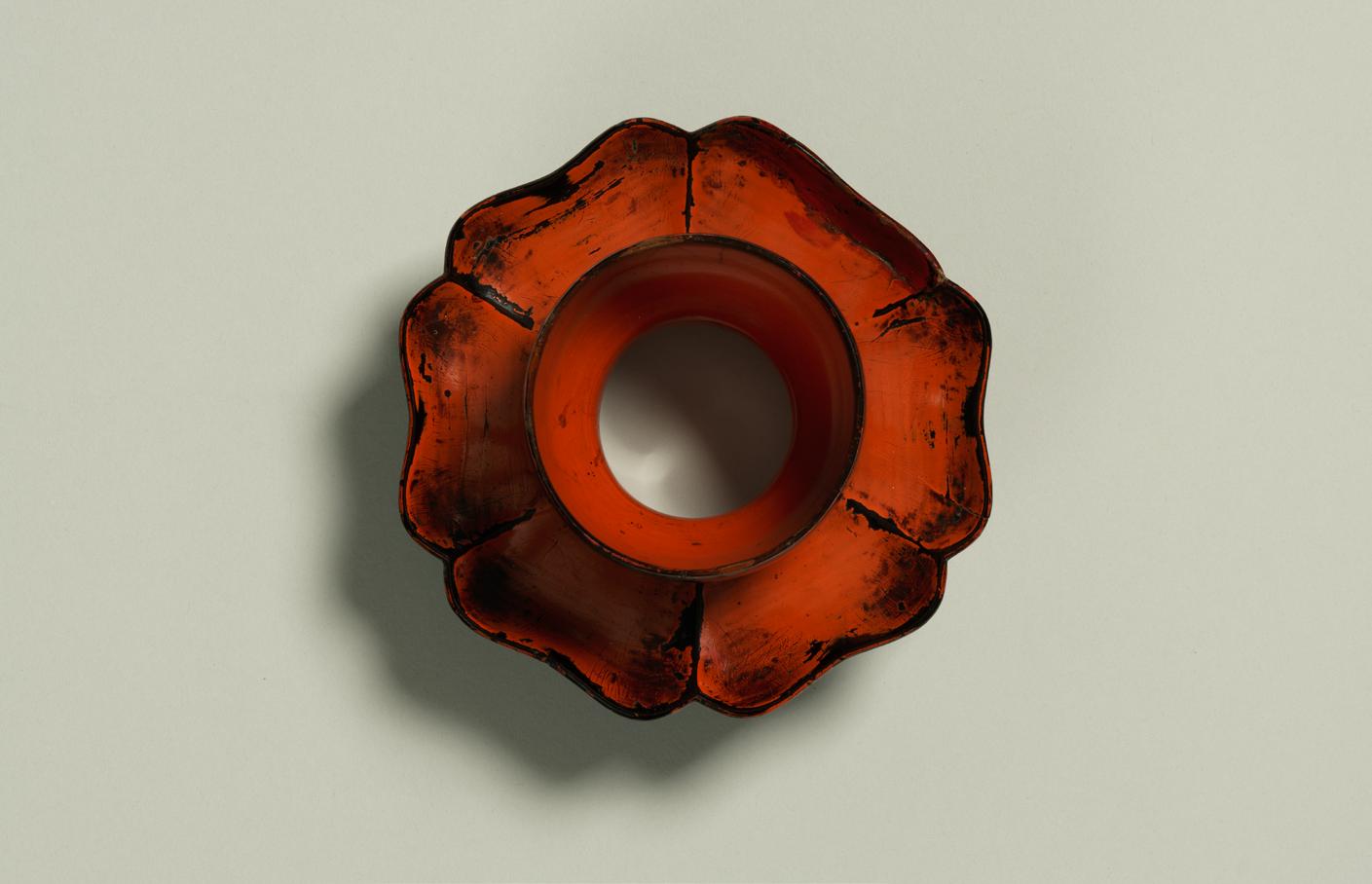
间 缀 一 花 苞 与 两
朵
盛
放 莲 花 ; 耳 上
錾 刻 果 实 枚 ,
金 鋬 耳 杯 杯 体 圆 形 , 敞 口 , 浅 腹 , 平 底 , 卷 沿 。 口 沿 侧 凸 出 扁 平 花 瓣 形 耳 , 耳 下 配 环 形 柄 。 杯 心 錾 刻 精 美 纹 饰 , 呈 现 枝 叶 扶 疏 之 景 , 其
八 金 鋬 耳 杯 西 夏 , 金 或 元 公 元 十 二 世 纪 十 三 世 纪 宽 十 . 四 公 分 口 径 九 . 四 公 分 高 二 . 九 公 分
8
Gold cup with chased decoration Xixia, Jin or Yuan dynasty, 12th - 13th century
Max width: 11.4cm
Cup diameter: 9.4cm
Height: 2.9cm
Shallow rounded gold cup supported on a flat base, the sides rising to a narrow, rolled rim. A flanged thumb-rest with narrow beaded edge extends from the rim, set with a small ring handle beneath. The interior of the cup is delicately chased with leafy branches bearing two large lotus blooms and a single bud, while the gently lobed flange is decorated with a fruit flanked by a symmetrically arranged leafy branches. The exterior sides are undecorated, bearing a softly burnished patina.
Provenance:
Zhang Renjie (1877-1950), Tonying and Company, Paris, Shanghai, New York.
Mrs Christian R. Holmes (1871-1941), Long Island.
The Honorable Hugh Scott (1900 - 1994), Pennsylvania. Private collection, Switzerland.
J. J. Lally & Co., New York.
Exhibited:
Allentown, Pennsylvania, 1968, Allentown Art Museum. Fredericksburg, Virginia, 1968, Mary Washington College Art Gallery, University of Virginia.
Philadelphia, Pennsylvania, 1969, University of Pennsylvania Museum. Richmond, Virginia, 1969, Virginia Museum of Fine Arts. Pittsburgh, Pennsylvania, 1969, University of Pittsburgh Art Gallery.
Pittsburgh, Pennsylvania, 1970, Carnegie Mellon University. New York, 1971 - 1972, China Institute in America. New York, 2012, J. J. Lally & Co.
Published:
H. Scott, The Golden Age of Chinese Art: The Lively Tang Dynasty , Tokyo, 1966, page 49, number 12.
R. D. Kinsman, Chinese Art from the Collection of the Hon. Hugh Scott , Fredericksburg, Virginia, 1968, number 17a-b.
Wang Yi-t’ung and B. Wiant, Chinese Art from the Collections of the Honorable Hugh Scott , Pittsburgh, 1970, no. 20-12.
P. Singer, Early Chinese Gold & Silver , China Institute in America, New York, 1971, page 68, number 98.
Sotheby’s New York, Fine Chinese Ceramics and Works of Art , 4 June 1985, number 37.
J. J. Lally & Co., Silver and Gold in Ancient China , New York, 2012, number 38.
Christie’s, New York, J. J. Lally & Co ., 23 March 2023, number 817.
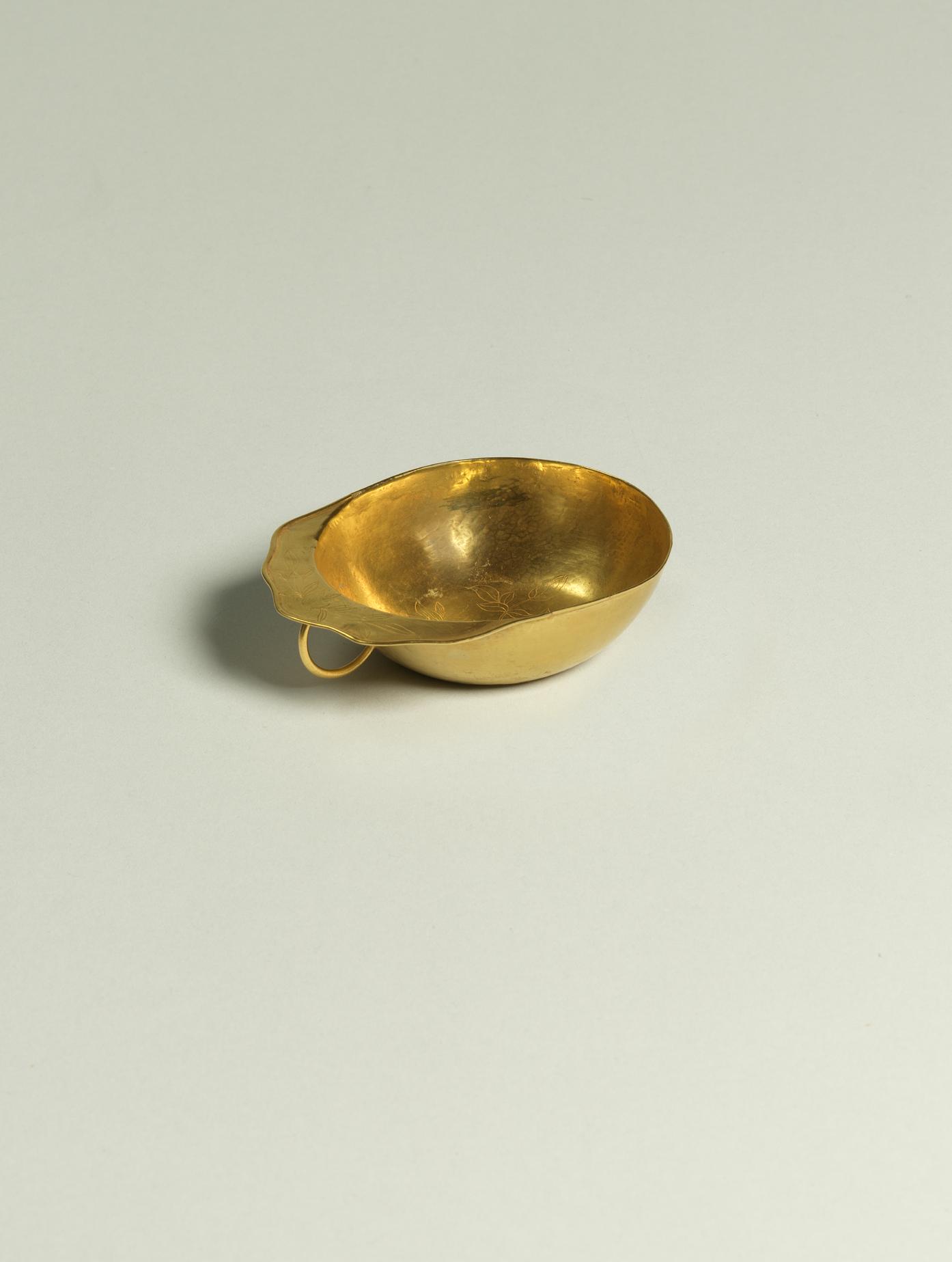
Similar examples:
Rose Kerr, Chinese Art and Design , London, 1991, page 174, number 78 for an example of a gold cup with chased designs formerly in the collection of George Eumorfopoulos and now in the Victoria and Albert Museum; see also, Susan Whitfield, The Silk Road: Trade, Travel, War and Faith , London, 2004, page 239, plate 169.
Shanghai Museum ed., Treasures on Grassland, Archaeological Finds from the Inner Mongolia Autonomous Region , Shanghai, 2000, page 252 for a similar gold cup with a crescent-shaped thumb-rest with chased scroll motifs, dated to the Yuan dynasty, found in Wujiadicun, Wuguquan village, Xinghe county and now in the Inner Mongolia Museum.
Nanjing Museum ed., The Golden China, Gold Artifacts of Ancient China , Nanjing, 2013, page 248, lower image, for an example with a pair of dragons decorating the thumb-rest, dated to the Yuan dynasty, found at the Wuyi Ranch, Plain Blue Banner, Xilingol League and now in the Inner Mongolia Museum.
B. Gyllensvärd, Chinese Gold and Silver in the Carl Kempe Collection , Stockholm, 1953, number 136 for a silver example incised in the well with a lotus spray.
For further discussion on this cup, refer to the essay, ‘A Cup of Gold with Lotus Flowers’ by Sarah Wong on pages 6 - 15 of this catalogue.
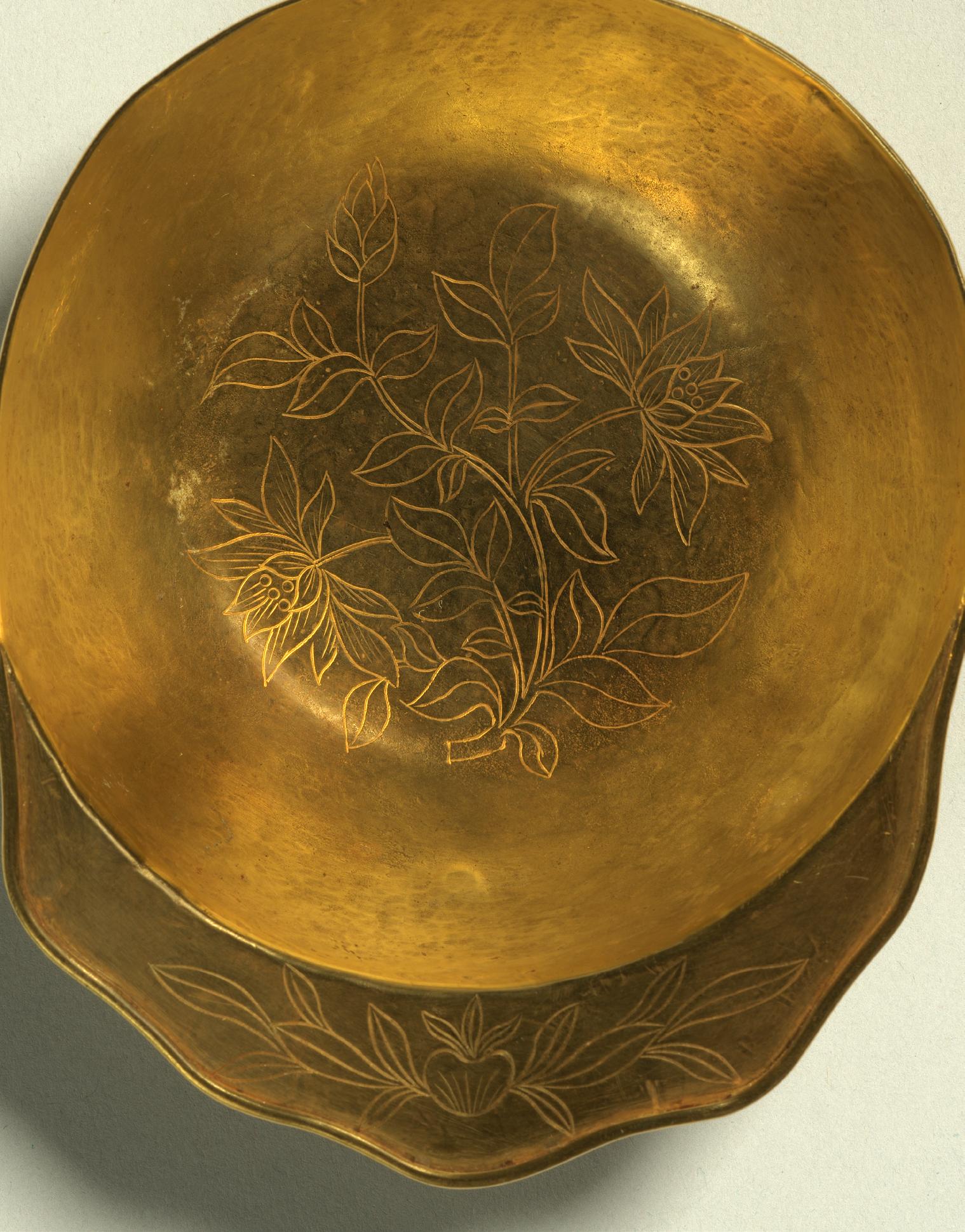
葵
口
铜
碟 一 对 ,
平 底
可
见
口 径
十 . 〇
公 分
和
十 . 公 分
9
Pair of bronze ‘mallow-shaped’ dishes
Song dynasty, 960 - 1279
Diameter: 11.0cm and 11.1cm
Pair of bronze ‘mallow-shaped’ dishes. Each dish has a flat base with distinct turning marks and low, everted sides with a lobed rim, resembling the radiating petals of a mallow flower. The silvery-bronze surface bears small areas of encrustation on the interior and the exterior.
Provenance:
Dr Johan Carl Kempe (1884 - 1967), Sweden, before 1953 (no. CK170).
A Princely Collection, 2008 - 2019.
Exhibited:
Washington, D.C., 1954 - 1955, Smithsonian Institution.
Ulrice hamn, c. 1999 - 2008, The Museum of Art and Far Eastern Antiq uities in Ulricehamn.
Published:
B. Gyllensvärd, Chinese Gold and Silver in the Carl Kempe Collection , Stockholm, 1953, number 170.
式 ,
宛
若
锦
葵
绽
放
之
态 。
器
身
内
外
皆
分
布
有
少
许
绿
锈 。
Bo Gyllensvärd, Chinese Gold and Silver in the Carl Kempe Collection , Smithsonian Institute, Washington D. C., 1954 - 1955, number 170.
The Museum of Art and Far Eastern Antiquities in Ulricehamn, Chinese Gold and Silver in the Carl Kempe Collection , Ulricehamn, 1999, number 163.
Sotheby’s, London, Masterpieces of Chinese Precious Metalwork - Early Gold and Silver , 14 May 2008, number 109.
Christie’s, New York, Masterpieces of Early Chinese Gold and Silver , Property from a Princely Collection , 12 September 2019, number 585.
Similar example:
Yang Zhishui et al., The Discovery and Research on Gold and Silver Wares Unearthed from Caches of Song and Yuan Dynasties in Hunan , Beijing, 2009, page 297, number 610 for a larger silver dish with lobed rim, excavated from a Yuan hoard in Mingjing village, Hongshantou, Huarong county, Hunan province.
Although these dishes have previously been assumed to be beated silver, recent analysis has shown that they are in fact made of high tin-content bronze, composed of approximately 76% copper and 22% tin, with less than 1% trace elements. Tin and tin compounds naturally form an oxide layer on the surface when exposed to air. The oxide acts as a barrier, preventing further oxidation and corrosion and tin itself also apparently possesses anti-fungal properties, all of which would mean this pair would have been eminently suitable for serving food at a banquet or used as offering dishes.

釉
Small blue-glazed stoneware dish
Northern Song or Jin dynasty, 12th - 13th century Jun kilns, Henan province
Diameter: 11.5cm
Small circular flat stoneware dish with everted lip, standing on a low footring, covered with an attractive, thick, lavender-blue glaze, thinning at the rim. The glaze falls in thick droplets around the exterior of the neat footring, stopping short of the underside to reveal the body which has fired to a dark brown colour.
Provenance:
Eskenazi Limited, London, 1978 - 1979.
The Guennol Collection (Alastair Bradley Martin [1917 - 2010] and Edith Park Martin [1917 - 1989]), New York, acquired from the above in 1979, and then by descent.
Published:
Sotheby’s, Hong Kong, Important Chinese Ceramics and Works of Art , 28 November 1978, number 22.
Amy G. Poster, ‘Chun-yao Glazed Stoneware Dish’, The Guennol Collection , volume II, New York, 1982, page 87.
Similar examples:
Rose Kerr, Song Dynasty Ceramics , London, 2004, page 33, figure 23 for an example in the Victoria and Albert Museum; see also, Rose Kerr, Dazzling Official Jun Wares from Museums and Collections Around the World , UK, 2012, page 52, number 29.
University Museum and Art Gallery, The University of Hong Kong, Alchemy in Blue, Ancient Jun ware from the Yip Collection , Hong Kong, 2008, pages 44 - 45, numbers 16 and 17, for two examples shown with accompanying bowls.
Eskenazi London, Junyao , London, 2019, number 4 for an example with a bowl.
Small saucer dishes such as the present example could either have been used as a small serving dish or as the cover for a low, wide-mouthed tea bowl, as shown in the examples from the Yip collection, cited above. The dishes may have been designed to be multifunctional, perhaps intended for keeping the tea warm in a bowl, as well as for holding sweetmeats.
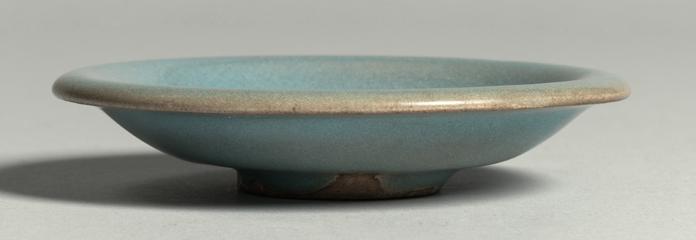

Blue-glazed splashed stoneware dish
Jin dynasty, 12th - 13th century
Jun kilns, Henan province
Diameter: 17.7cm
Blue-glazed purple-splashed grey stoneware dish with low sides and wide everted rim. The dish is covered all over with a sky-blue glaze, with a wide crackle, thinning to an olive colour at the rim and suffused on the interior with a rich mauve splash incorporating plum and greenish tones. The base is glazed, has five spur marks and a low foot-ring that has been partially wiped clean of glaze and fired in places to a reddish tone.
Provenance:
Oscar Björck, Sweden (by repute).
Klas Fahraeus, Sweden. Private collection, Sweden.
Eskenazi Limited, London, 2012 - 2013.
Exhibited:
London, 2013, Eskenazi Limited.
Published:
Sotheby’s, London, Fine Chinese Ceramics and Works of Art , 16 May 2012, number 85.
Eskenazi London, Junyao , London, 2019, number 10.
Similar examples:
Porcelain of the National Palace Museum, Chün Ware of the Sung Dynasty , Hong Kong, 1961, number 38, plates 38a and 38b; see also, National Palace Museum, A Panorama of Ceramics in the Collection of the National Palace Museum: Chün Ware , Taipei, 1999, pages 148 - 149, number 56.
Aichi Prefectural Museum, Masterworks of Eastern Ceramics: An Exhibition to Commemorate the Museum’s Full Opening , Aichi, 1994, page 122, plate 44.
Illustrated Catalogue of Ru, Guan, Jun, Guangdong and Yixing Wares in the Percival David Foundation of Chinese Art , Section 1 , London, 1999, number 93, plate 39 for a slightly larger example; see also, Stacey Pierson with S. F. M. McCausland , Song Ceramics, Objects of Admiration , London, 2003, plate 47; see also, Rosemary Scott, Imperial Taste, Chinese Ceramics from the Percival David Foundation , London and Los Angeles, 1989, page 39, number 15.
Rose Kerr, Song Dynasty Ceramics , London, 2004, page 34, plate 26 for the example in the Victoria and Albert Museum.
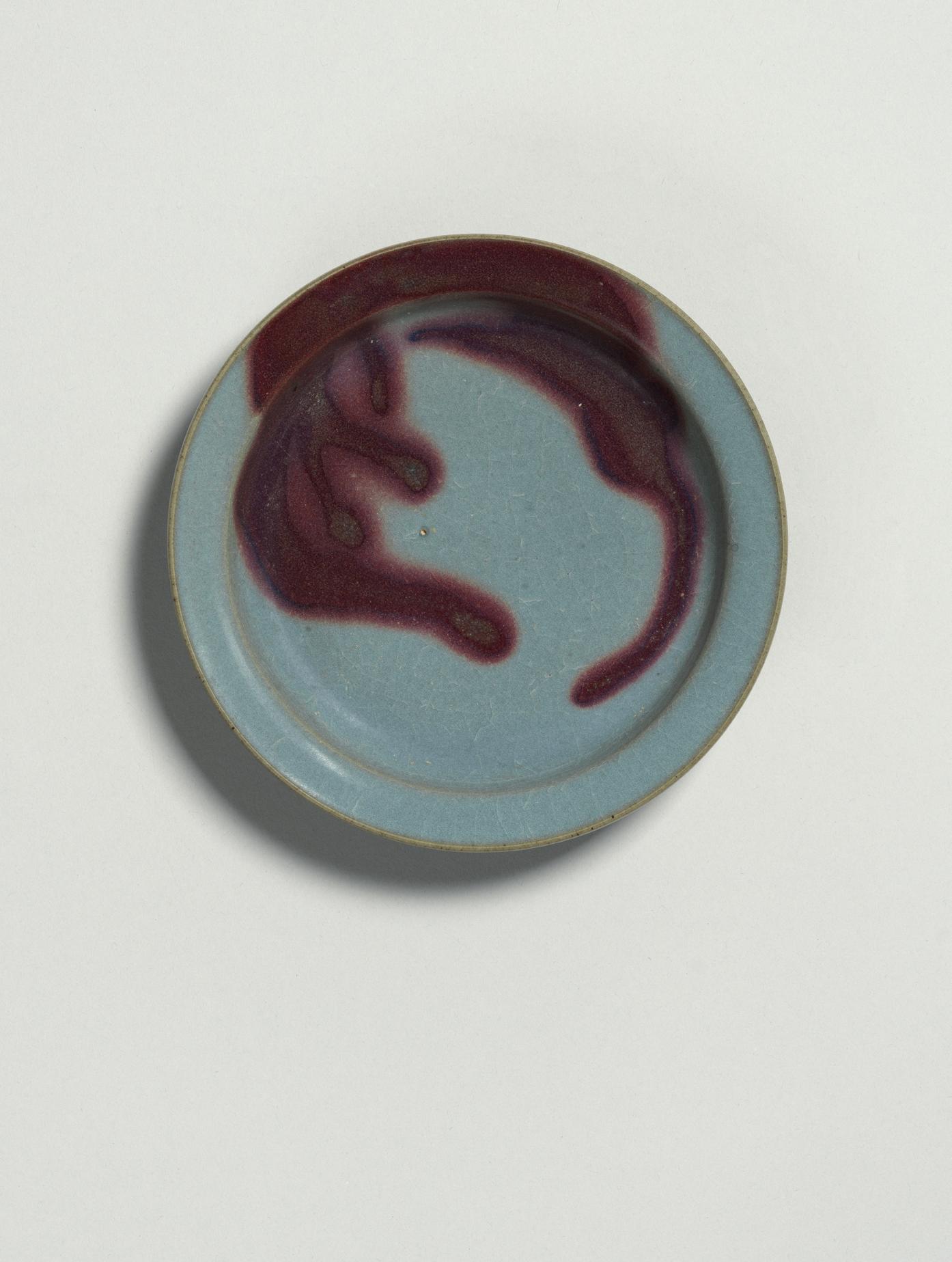
The striking use of rich purple copper oxide ‘splashes’ against the characteristic blue ground is seen primarily on Jun wares from the Jin period (1115 - 1234). The dramatic colour contrasts and apparently ‘random’ splashes must have been particularly startling within the context of Northern Song ceramics, reliant as they were, on simplicity of form and monochrome glazes. In the case of the ‘splashed’ Jun wares, copper oxide was applied to the dried glaze before the vessel was fired in a reduction kiln. Although on many pieces a splashed effect appears spontaneous, it is likely that a brush was often used for the application of the copper oxide, with brush strokes evident in some cases. In some instances, as in the present example, a green tone is visible within the purple and magenta hues, the result of small amounts of copper pigment re-oxidizing during the cooling in the kiln.

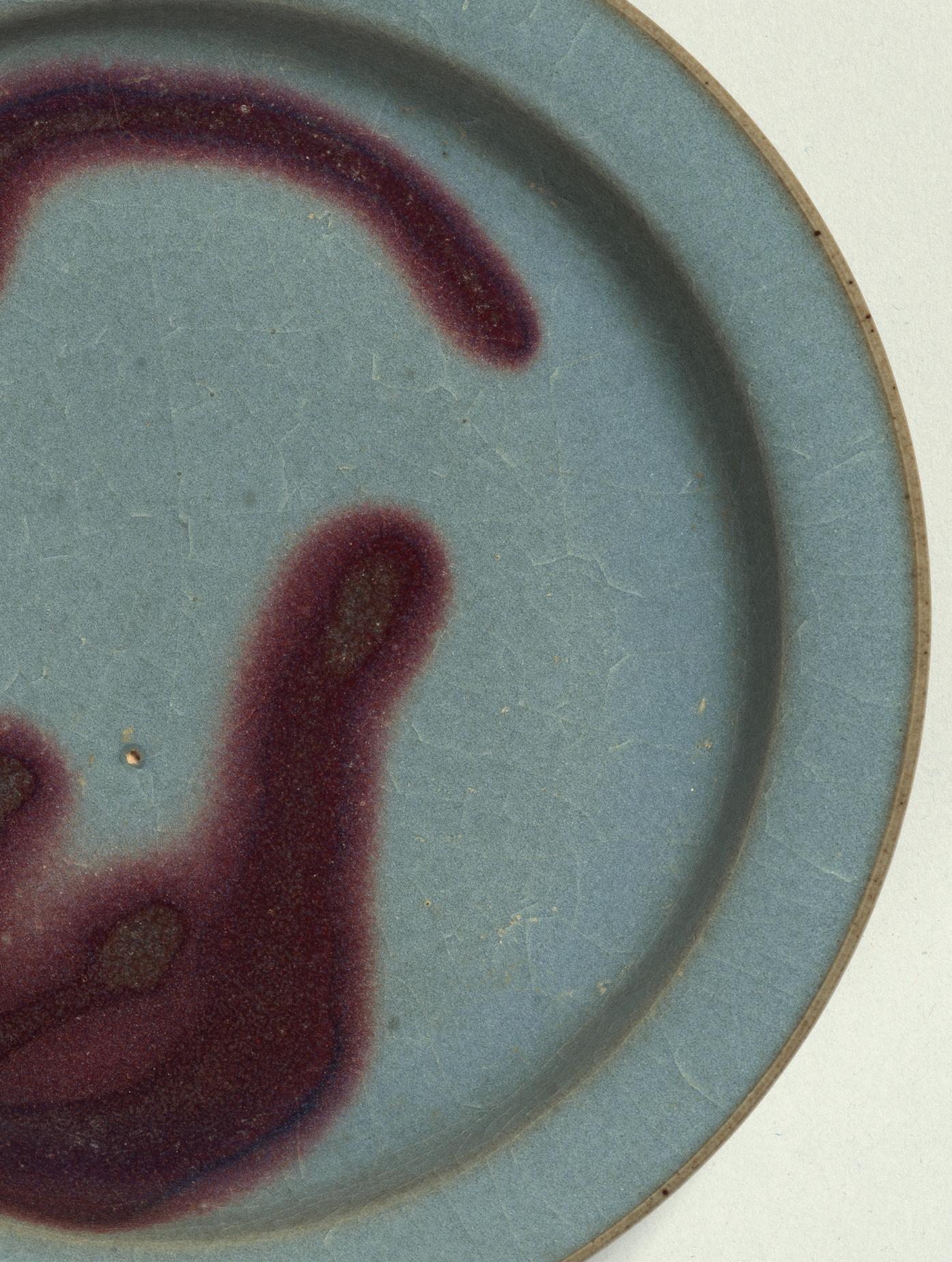
叶 卷 曲 , 上 带 三
朵
盛
放 莲 花 。 下
腹 饰 卷
草 纹 窄 带 , 近 足 处 饰
梅 瓶 灰 胎 , 小 口 , 尖 圆 唇 , 微 束 颈 , 瓶 身 修 长 微 鼓 , 下
收 至 圈 足 , 底 足 内 凹 。 器 身 主 纹 饰 带 于 灰 褐 地 上 剔 刻 白 色 化 妆 土 , 饰 缠 枝 莲 纹 , 枝
十 二
磁 州 窑 河 北 或 河 南 省 高 三 十 五 . 八 公 分
剔 莲 纹 梅 瓶 金 公 元 十 二 世 纪 十 三 世 纪
Glazed stoneware vase ( meiping )
Jin dynasty, 12th - 13th century Cizhou ware, Hebei or Henan province
Height: 35.8cm
Glazed grey stoneware vase ( meiping ), with short neck, truncated, flattened, conical mouth and slender, slightly swelling body tapering to the foot and recessed base. The vase is carved with a central band of leafy scrolls bearing three large lotus blooms, the creamy white slip cut away to reveal the design against a buff-coloured ground. A narrow band of freely incised scrolling tendrils encircles the lower body, above a band of overlapping lotus lappets. The vase is covered with transparent glaze apart from the underside of the foot and the base, which are unglazed.
Provenance:
Private collection, Hong Kong.
Similar example:
Osaka Municipal Museum of Art, Special Exhibition, Charm of Black & White Ware; Transition of Cizhou Type Ware s, Osaka, 2002, number 37 for a very similar example decorated with peony flowers.
On the present example, as on many Cizhou pieces, at least two decorative techniques are used. Here, sgraffito is used on the main band where the creamy white slip has been cut away to reveal the design, against the darker, buff coloured body. On the band below, the decoration has been created by light incising.
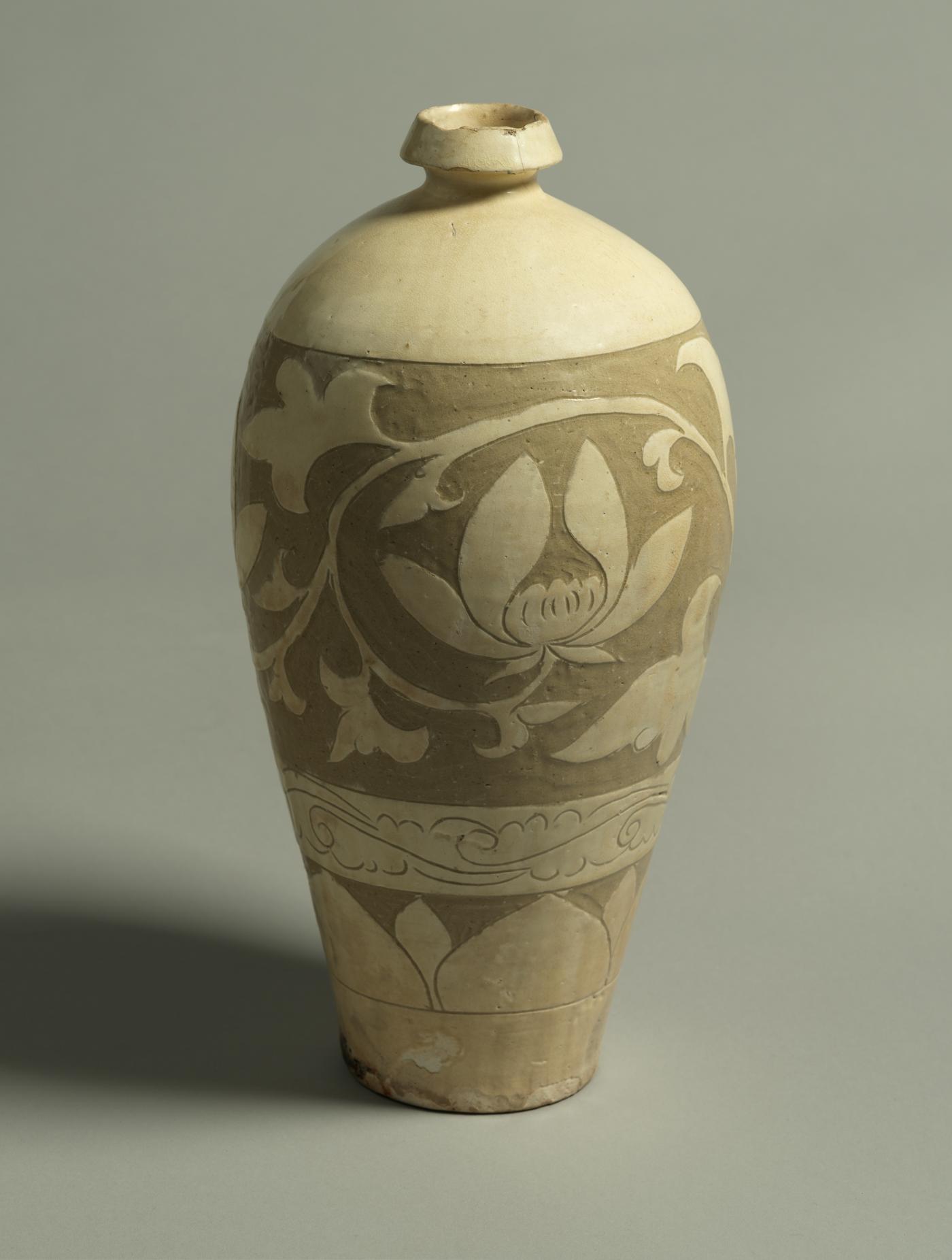

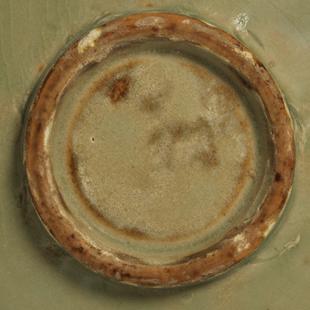
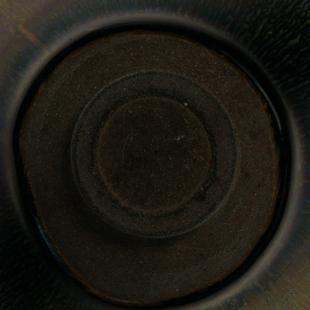
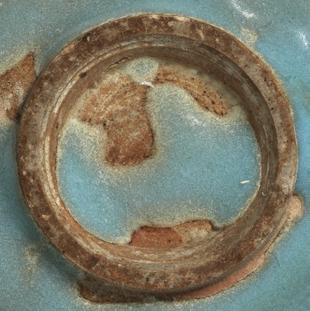

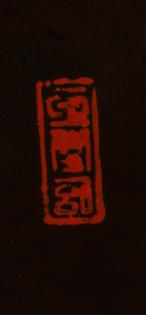
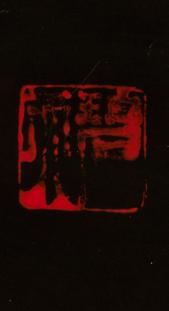
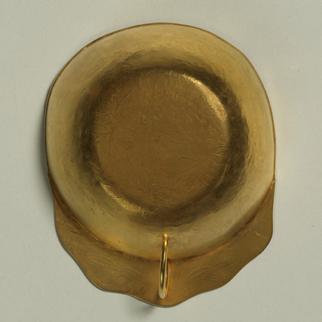
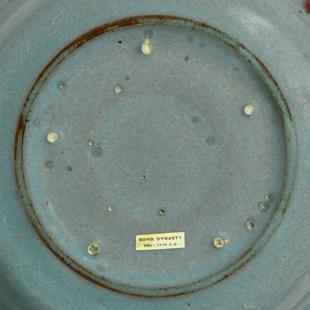
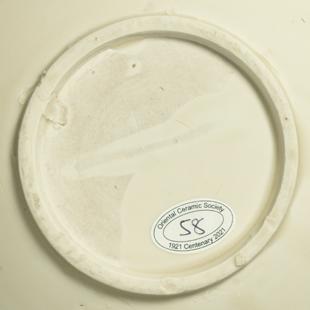
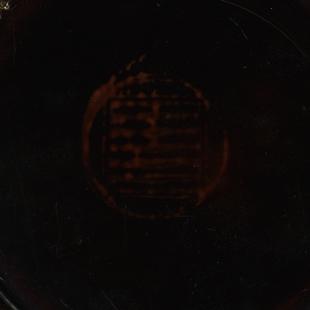


Ayers, J.: Chinese Ceramics in The Baur Collection , volumes 1 and 2, Geneva, 1999.
Chinese Gold and Silver in the Carl Kempe Collection , The Museum of Art and Far Eastern Antiquities in Ulricehamn, Ulricehamn, 1999.
Degawa, T. et al.: Porcelaine, chefs-d’oeuvre de la collection Ise , Paris, 2017.
Eskenazi Limited, Principal wares of the Song period from a private collection , London, 2015.
Eskenazi Limited, Song: Chinese ceramics, 10 th to 13 th century , London, 2003.
Eskenazi Limited, Song: Chinese ceramics, 10 th to 13 th century (part 3) , London, 2007.
Eskenazi Limited, Junyao , London, 2013.
Fujio Koyama ed.: Toki zenshu 26, Temmoku (Encyclopaedia of Ceramics 26, Temmoku ), Tokyo, 1969.
Fujio Koyama: Toji taikei 38, Temmoku (Outline of Ceramics 38, Temmoku ), Tokyo, Heibonsha series, Tokyo, 1974.
Gakuji Hasebe: Chinese Ceramics, Cizhou Ware , volume 7, Heibonsha, Japan, 1996.
Garner, H.: Chinese Lacquer , London, 1979.
Gompertz, G. St. G. M.: Chinese Celadon Wares , London and Boston, 1958.
Gray, B.: Sung Porcelain and Stoneware , London, 1984.
Gyllensvärd, B.: Chinese Gold and Silver in the Carl Kempe Collection , Smithsonian Institute, Washington D. C., 1954 - 1955.
Hobson, R. L.: A Catalogue of Chinese Pottery and Porcelain in the Collection of Sir Percival David , London, 1934.
Hong Kong Museum of Art, Song Ceramics from the Kwan Collection , Hong Kong, 1994.
Idemitsu Museum of Arts, Chinese Ceramics in the Idemitsu Collection , Tokyo, 1987.
Idemitsu Museum of Arts, Sung Ceramics , Tokyo, 1979.
Kerr, R.: Song Dynasty Ceramics , London, 2004.
Kerr, R.: Yaozhou Wares from Museums and Art Institutes Around the World including Yaozhou Tribute Wares , Woodbridge, 2021.
Kuwayama, G.: Far Eastern Lacquer , Los Angeles, 1982.
Lam, P. Y. L. ed.: Layered Beauty, The Baoyizhai Collection of Chinese Lacquer , Art Museum, Institute of Chinese Studies, The Chinese University of Hong Kong, Hong Kong, 2010.
Li Huibing ed.: The Complete Collection of Treasures of the Palace Museum, Porcelain of the Song Dynasty (I and II), volumes 32 and 33, Hong Kong, 1996.
Li Zhiyan et al.: Song Ceramics, The Muwen Tang Collection Series 11 , Hong Kong, 2012, number 34.
Mino, Y.: Freedom of Clay through Seven Centuries in Northern China: Tz’u-chou Type Wares, 960 - 1600 A.D. , Bloomington, 1980.
Mowry, R. D.: Hare’s Fur, Tortoiseshell, and Partridge Feathers, Chinese Brownand Black-Glazed Ceramics, 400 – 1400 , Cambridge, Massachusetts, 1996.
Museum of Oriental Ceramics, Osaka ed., Celadon of Yaozhou Ware , Osaka, 1991.
Museum of Oriental Ceramics, Osaka ed., The Masterpieces of Yaozhou Ware , Tokyo, 1997.
Museum of Oriental Ceramics, The Masterpieces of Yaozhou Ware , Tokyo, 1997.
National Palace Museum ed., A Panorama of Ceramics in the Collection of the National Palace Museum: Chün Ware , Taipei, 1999.
National Palace Museum, Catalogue of the Special Exhibition of Ting Ware White Porcelain , Taipei, 1987.
National Palace Museum, Decorated Porcelains of Dingzhou, White Ding wares from the collection of the National Palace Museum , Taipei, 2014.
Nezu Institute of Fine Arts, White Porcelain of Ding yao , Tokyo, 1983.
Nezu Museum and Tokugawa Art Museum ed., Temmo , Tokyo, 1979.
Oriental Ceramic Society , Exhibition of Sung Dynasty Wares, Chün and Brown Glazes , London, 1952.
Osaka Municipal Museum of Art, S ō gen no bijutsu (Arts of the Song and Yuan), (Chinese Art Exhibition Series 4), Osaka, 1978.
Osaka Municipal Museum of Art, Charm of Black and White Ware; Transition of Cizhou Type Wares , Osaka, 2002.
Percival David Foundation of Chinese Art, Song Ceramics: Art History, Archaeology and Technology, Colloquies on Art and Archaeology in Asia No. 22 , London, 2004.
Pierson, S. with McCausland , S. F.M.: Song Ceramics, Objects of Admiration , London, 2003.
Seikado chawan (Seikado Tea bowls), Tokyo, 1974.
Sekai Toji Zenshu , (Ceramic Art of the World), [Old Series], volume 10, Tokyo, 1955.
Sekai Toji Zenshu , (Ceramic Art of the World), volume 12, Tokyo, 1977.
Soame Jenyns, R. and Watson, W.: Chinese Art, The Minor Arts, Gold, Silver, Bronze Cloisonné, Cantonese Enamel, Lacquer, Furniture, Wood , Fribourg, 1963.
The Art Institute of Chicago, Marvels of Celadon: The Shang Shan Tang Collection of Yaozhou Wares , Chicago, 2019.
The Palace Museum, Selection of Ding Ware, the Palace Museum’s Collection and Archaeological Excavation , Beijing, 2012.
The Palace Museum, Selection of Jun Ware, the Palace Museum’s Collection and Archaeological Excavation , Beijing, 2013.
The Seikado Foundation ed., Seikado Art Treasures , Tokyo, 1992.
Tokyo National Museum, Chinese Arts of the Sung and Yüan Periods , Tokyo, 1961.
Tokyo National Museum, Illustrated Catalogues of Tokyo National Museum, Chinese Ceramics , Tokyo, 1965.
Tregear, M.: Song Ceramics , Fribourg, 1982.
Uldry, P.: Chinesisches Gold und Silber, Die Sammlung Pierre Uldry , Zürich, 1994.
University Museum and Art Gallery, The University of Hong Kong, The Multiplicity of Simplicity: Monochrome wares from the Song to the Yuan dynasties , Hong Kong, 2012.
Watt, J. C. Y. and Ford, B. B.: East Asian Lacquer, The Florence and Herbert Irving Collection , New York, 1991.
Wirgin, J.: Sung Ceramic Designs , Stockholm, 1970.
Wong, S. and Pierson, S. eds.: Collectors, Curators, Connoisseurs: A Century of the Oriental Ceramic Society , 1921 - 2021 , London, 2021.
Wood, N.: Chinese Glazes , London, 1999.
Yutaka Mino: Freedom of Clay and Brush through Seven Centuries in Northern China: Tz’u-chou Type Wares, 960 - 1600 A.D. , Indianapolis, 1980.
Zhang Bai: Complete Collection of Ceramic Art Unearthed in China, 16 volumes, Beijing, 2008.
Works of art purchased from Eskenazi Ltd. London, are now in the following museum collections:
Ackland Art Museum, North Carolina
Arita Porcelain Park Museum, Saga
Art Gallery of New South Wales, Sydney
Art Gallery of South Australia, Adelaide
Art Institute of Chicago, Chicago
Arthur M. Sackler Gallery, Washington, DC
Ashmolean Museum, Oxford
Asia House, Mr and Mrs John D Rockefeller 3rd Collection, New York
Asian Art Museum of San Francisco, San Francisco
Asian Civilisations Museum, Singapore
Baltimore Museum of Art, Baltimore
Birmingham Museum of Art, Alabama
British Museum, London
Brooklyn Museum, New York
Chang Foundation, Taibei
Chung Young Yang Embroidery Museum, Sookmyung
Women’s University, Seoul, Korea
Cincinnati Art Museum, Cincinnati
Cleveland Museum of Art, Cleveland
Columbus Museum of Art, Columbus
Corning Museum of Glass, Corning
Dallas Museum of Art, Dallas
Dayton Art Institute, Dayton
Denver Art Museum, Denver
Designmuseum Danmark, Copenhagen
Didrichsen Art Museum, Helsinki
Fitzwilliam Museum, Cambridge
Flagstaff House Museum of Teaware, Hong Kong
Freer Gallery of Art, Washington, DC
Hagi Uragami Museum, Hagi
Hakone Museum of Art, Hakone
Harvard Art Museums, Cambridge, Massachusetts
Hetjens Museum, Düsseldorf
Hong Kong Museum of Art, Hong Kong
Honolulu Museum of Art, Honolulu
Idemitsu Museum of Arts, Tokyo
Indianapolis Museum of Art, Indianapolis
Israel Museum, Jerusalem
Istituto Italiano per il Medio ed Estremo Oriente, Rome
Kimbell Art Museum, Fort Worth
Kuboso Memorial Museum of Arts, Izumi, Osaka
Los Angeles County Museum of Art, Los Angeles
Louvre Abu Dhabi, Abu Dhabi
M Woods Museum, Beijing
Matsuoka Museum of Art, Tokyo
Metropolitan Museum of Art, New York
Miho Museum, Shigaraki
Minneapolis Institute of Art, Minneapolis
MOA Museum of Art, Atami
Musée Ariana, Geneva
Musée des arts asiatiques, Nice
Musée national des arts asiatiques Guimet, Paris
Musées royaux d’Art et d’Histoire, Brussels Museum für Asiatische Kunst, Berlin Museum für Kunst und Gewerbe, Hamburg Museum für Lackkunst, Münster
Museum für Ostasiatische Kunst, Cologne Museum of Fine Arts, Boston Museum of Fine Arts, Houston Museum of Islamic Art, Doha Museum of Oriental Ceramics, Osaka Museum Rietberg, Zurich
National Gallery of Australia, Canberra
National Gallery of Canada, Ottawa
National Gallery of Victoria, Melbourne
National Museum of Singapore, Singapore
Nelson-Atkins Museum of Art, Kansas City
Nezu Museum, Tokyo
Norton Simon Museum, Pasadena Östasiatiska Museet, Stockholm
Princeton University Art Museum, Princeton
Royal Ontario Museum, Toronto
St. Louis Art Museum, St. Louis
Seattle Art Museum, Seattle
Shanghai Museum, Shanghai
Speed Art Museum, Louisville
State Administration of Cultural Heritage, Beijing
Toguri Museum of Art, Tokyo
Tokyo Fuji Art Museum, Tokyo
Tokyo National Museum, Tokyo
Tsui Museum of Art, Hong Kong
Tsz Shan Monastery Buddhist Art Museum, Hong K ong
Victoria and Albert Museum, London
Virginia Museum of Fine Arts, Richmond
Worcester Art Museum, Worcester
Zhiguan Museum of Fine Art, Beijing
Previous Exhibitions
March 1972 Inaugural exhibition Early Chinese ceramics and works of art.
June 1972 Georges Rouault, an exhibition arranged by Richard Nathanson.
June 1973 Ancient Chinese bronze vessels, gilt bronzes and early ceramics.
November 1973 Chinese ceramics from the Cottle collection.
December 1973 Japanese netsuke formerly in the collection of Dr Robert L Greene.
June 1974 Early Chinese ceramics and works of art.
November 1974 Japanese inro - from the collection of E A Wrangham.
May 1975 Japanese netsuke and inro - from private collections.
June 1975 Ancient Chinese bronzes from the Stoclet and Wessén collections.
June 1976 Chinese jades from a private collection.
June 1976 Michael Birch netsuke and sculpture.
June 1976 Japanese netsuke and inro - from private collections.
June 1977 Ancient Chinese bronze vessels, gilt bronzes and sculptures; two private collections, one formerly part of the Minkenhof collection.
June 1978 Ancient Chinese sculpture.
June 1978 Michael Webb netsuke.
June 1978 Eighteenth to twentieth century netsuke.
June 1979 Japanese netsuke from private collections.
June 1980 Jap anese netsuke from private collections and Michael Webb net suke.
July 1980 Ancient Chinese bronzes and gilt bronzes from the Wessén and other collections.
December 1980 Chinese works of art from the collection of J M A J Da wson.
October 1981 Japanese netsuke and inro - from the collection of Professor and Mrs John Hull Grundy and other private collections.
December 1981 Ancient Chinese sculpture.
October 1982 Japanese inro - from private collections.
November 1983 Michael Webb, an English carver of netsuke.
October 1984 Japanese netsuke, ojime, inro - and lacquer-ware.
June 1985 A ncient Chinese bronze vessels, gilt bronzes, inlaid bronzes, silver, jades, ceramics – Twenty five years.
December 1986 Japanese netsuke, ojime, inro - and lacquer-ware.
June 1987 Tang.
June 1989 Chinese and Korean art from the collections of Dr Franco Vannotti, Hans Popper and others.
November 1989 Japanese lacquer-ware from the Verbrugge collection.
December 1989 Chinese art from the Reach family collection.
May 1990 Japanese netsuke from the Lazarnick collection.
June 1990 Ancient Chinese sculpture from the Alsdorf collection and others.
November 1990 The Charles A Greenfield collection of Japanese lacquer.
June 1991 Inlaid bronze and related material from pre-Tang China.
November 1992 Japanese lacquer-ware – recent acquisitions.
December 1992 Chinese lacquer from the Jean-Pierre Dubosc collection and others.
June 1993 Early Chinese art from tombs and temples.
June 1993 Japanese netsuke from the Carré collection.
June 1994 Yuan and early Ming blue and white porcelain.
June 1995 Early Chinese art: 8th century BC – 9th century AD.
October 1995 Adornment for Eternity, loan exhibition from the Denver Art Museum.
June 1996 Sculpture and ornament in early Chinese art.
November 1996 Japanese inro - and lacquer-ware from a private Swedish collection.
March 1997 Ceramic sculpture from Han and Tang China.
June 1997 Chinese Buddhist sculpture.
June 1997 Japanese netsuke, ojime and inro - from the Dawson collection.
November 1997 Japanese netsuke – recent acquisitions.
March 1998 Animals and animal designs in Chinese art.
June 1998 Japanese netsuke, ojime and inro - from a private European collection.
November 1998 Chinese works of art and furniture.
March 1999 Ancient Chinese bronzes and ceramics.
November 1999
Ancient Chinese bronzes from an English private collection.
March 2000 Masterpieces from ancient China.
November 2000 Chinese furniture of the 17th and 18th centuries.
March 2001 Tang ceramic sculpture.
November 2001 Chinese ceramic vessels 500 – 1000 AD.
March 2002 Chinese Buddhist sculpture from Northern Wei to Ming.
November 2002 Two rare Chinese porcelain fish jars of the 14th and 16th centuries.
March 2003 Chinese works of art from the Stoclet collection.
November 2003 Song: Chinese ceramics, 10th to 13th century.
March 2004 Chinese Buddhist figures.
November 2004 A selection of Ming and Qing porcelain.
March 2005 Ancient Chinese bronzes and sculpture.
November 2005 Song ceramics from the Hans Popper collection.
March 2006 A selection of early Chinese bronzes.
June 2006 Recent paintings by Arnold Chang.
November 2006 Chinese porcelain from the 15th to the 18th century.
March 2007 Song: Chinese ceramics, 10th to 13th century (part 3).
November 2007 Mountain landscapes by Li Huayi.
March 2008 Chinese sculpture and works of art.
October 2008 Chinese ceramics and stone sculpture.
October 2009 Seven classical Chinese paintings.
March 2010 Trees, rocks, mist and mountains by Li Huayi.
November 2010 Fiftieth anniversary exhibition: twelve Chinese masterworks.
March 2011 Early Chinese metalwork in gold and silver; works of art of the Ming and Qing dynasties.
November 2011 Chinese huanghuali furniture from a private collection.
November 2011 The twelve animals of the zodiac by Li Huayi.
November 2012 Qing porcelain from a private collection.
October 2013 Junyao.
October 2013 Bo Ju Gui: an important Chinese archaic bronze.
October 2014 Waterfalls, rocks and bamboo by Li Huayi.
October 2014 Chinese sculpture c. 500 - 1500.
May 2015 Principal wares of the Song period from a private collection.
October 2015 Transfigured echoes: recent paintings by Liu Dan.
October 2016 Recent paintings by Zeng Xiaojun.
November 2016 Early Chinese art from private collections.
November 2017 Six Dynasties art from the Norman A. Kurland collection, Part one.
May 2018 Song: Chinese ceramics, 10th to 13th century (part 5).
May 2018 Gogottes: a rift in time.
November 2018 Six Dynasties art from the Norman A. Kurland collection, Part two.
November 2019 Room for study: fifty scholars’ objects.
October 2021 Tang: ceramics, metalwork and sculpture.
June 2022 Contemporary bamboo: masters from Japan.
June 2022 Gogottes: unfolding time.
October 2022 50 years of exhibitions: five masterpieces on loan from a private family collection
June 2023 Between perfection and destruction: Fang Lijun porcelain sculpture.
June 2023 Bamboo masterworks from Japan - classical to contemporary.
October 2023 Chinese ceramics, lacquer and gold from the 12th to the 14th century
June 2024 Elegant playthings in wood, lacquer and stone.
November 2024 Blue and white porcelain from the Yuan and early Ming dynasties.
May 2025 Bamboo and lacquer masterworks by Ikeda Iwao.
May 2025 Bamboo masterworks by Fujitsuka Shosei.
London W1S 2LJ
Telephone: 020 7493 5464
e-mail: gallery@eskenazi.co.uk
web: www.eskenazi.co.uk
